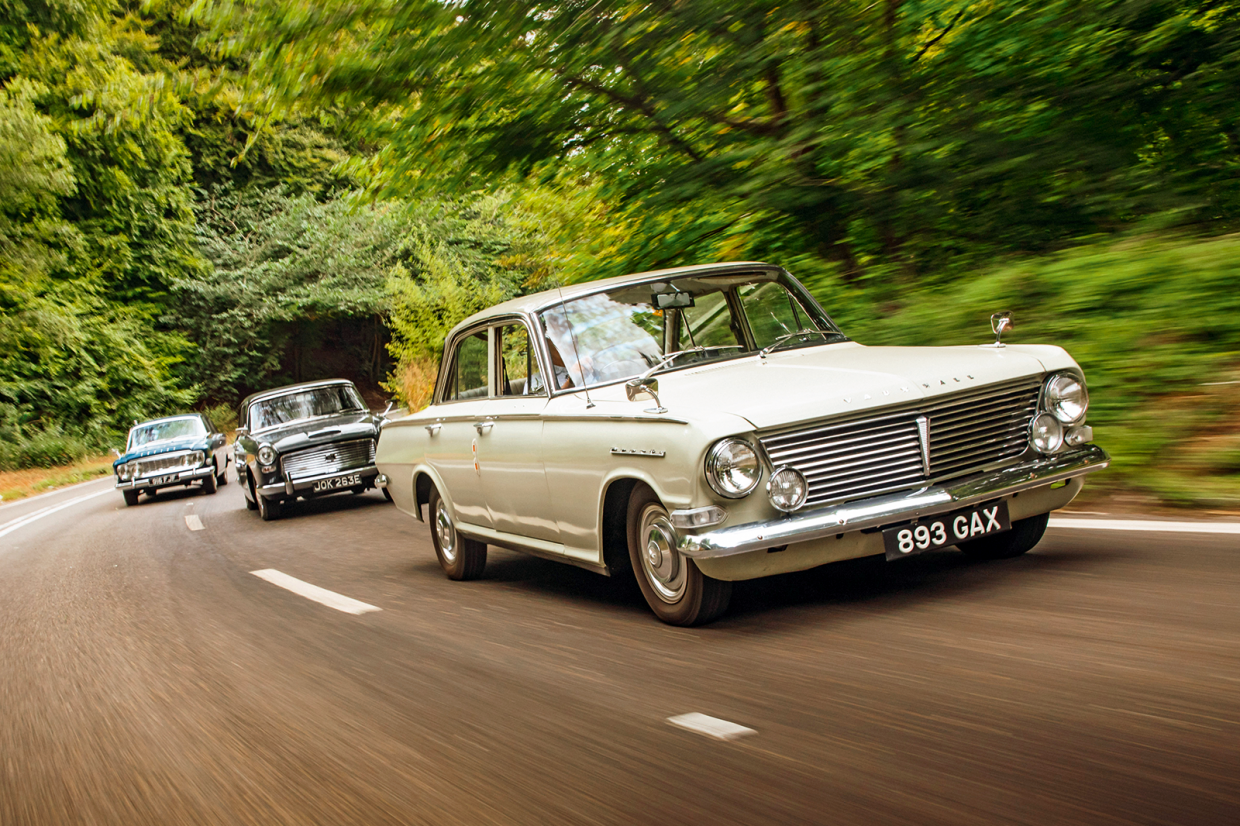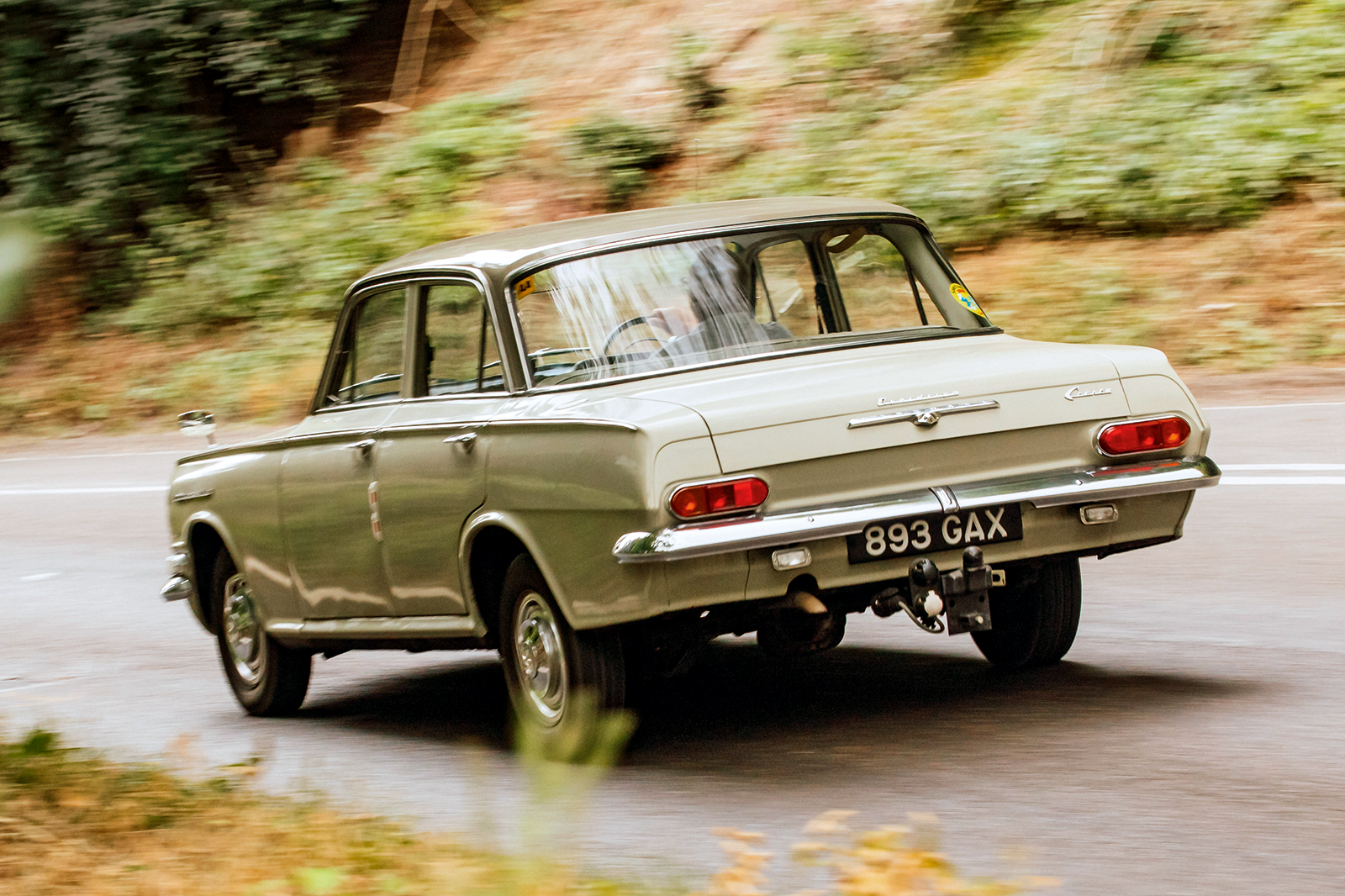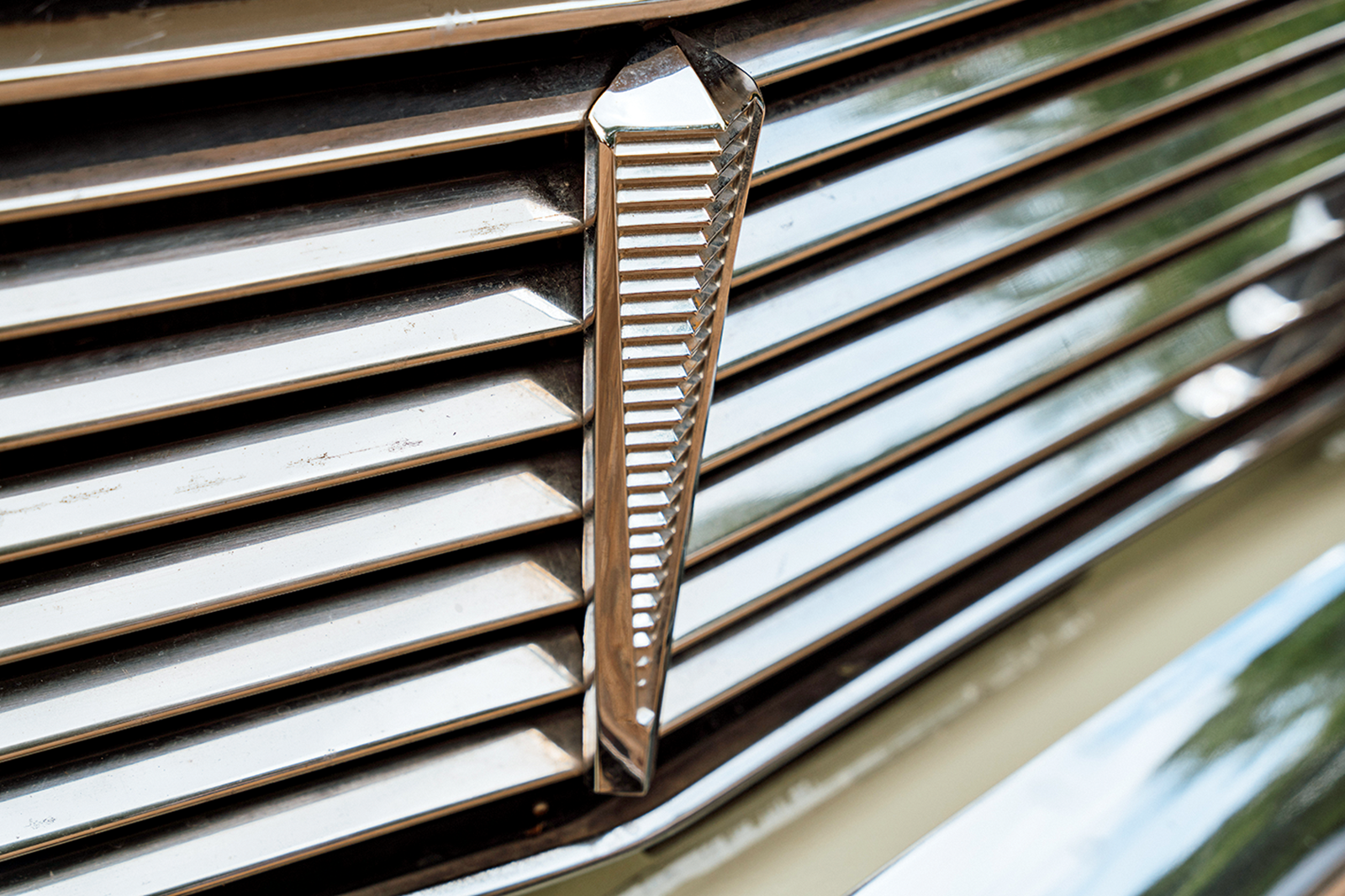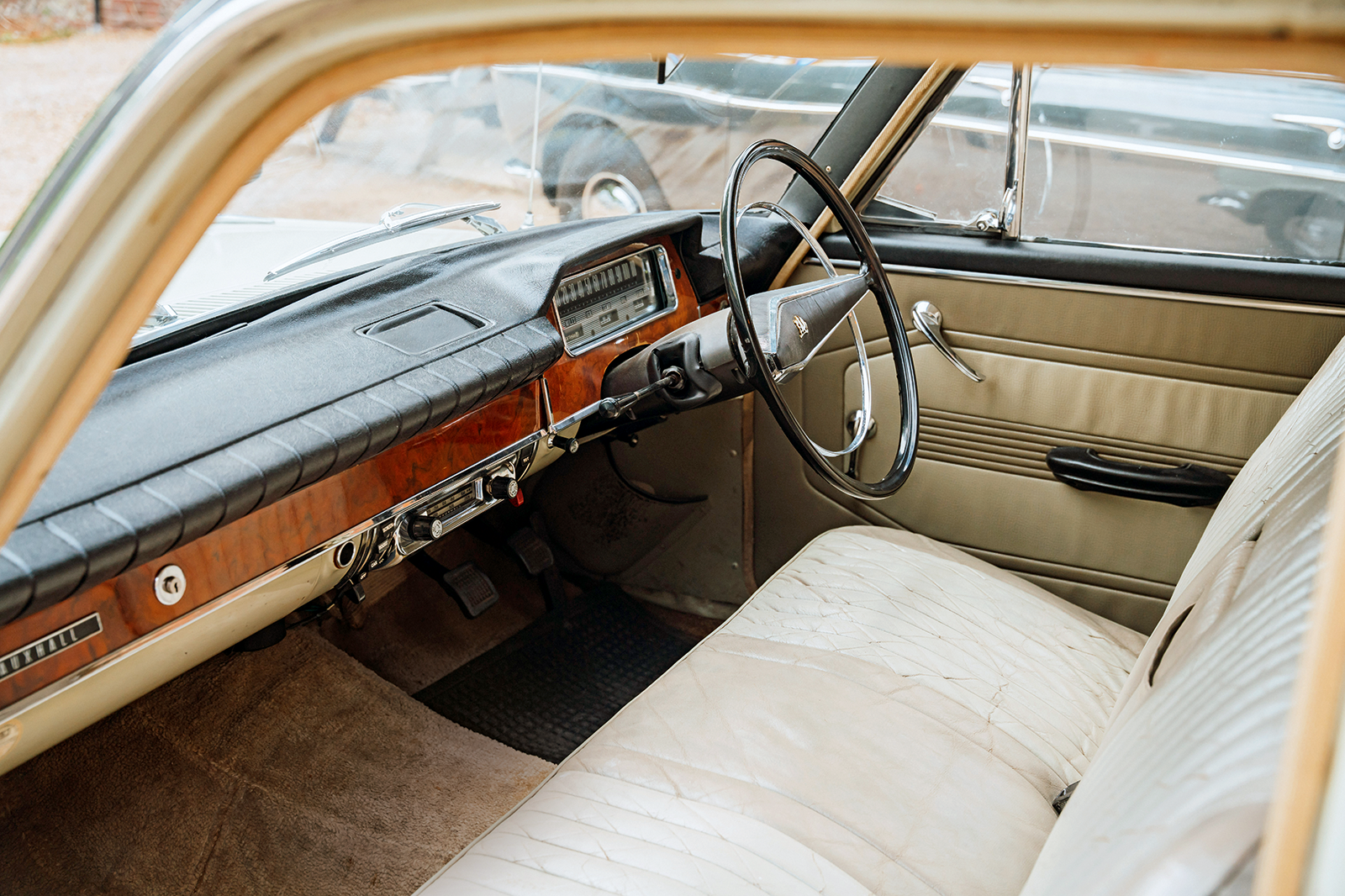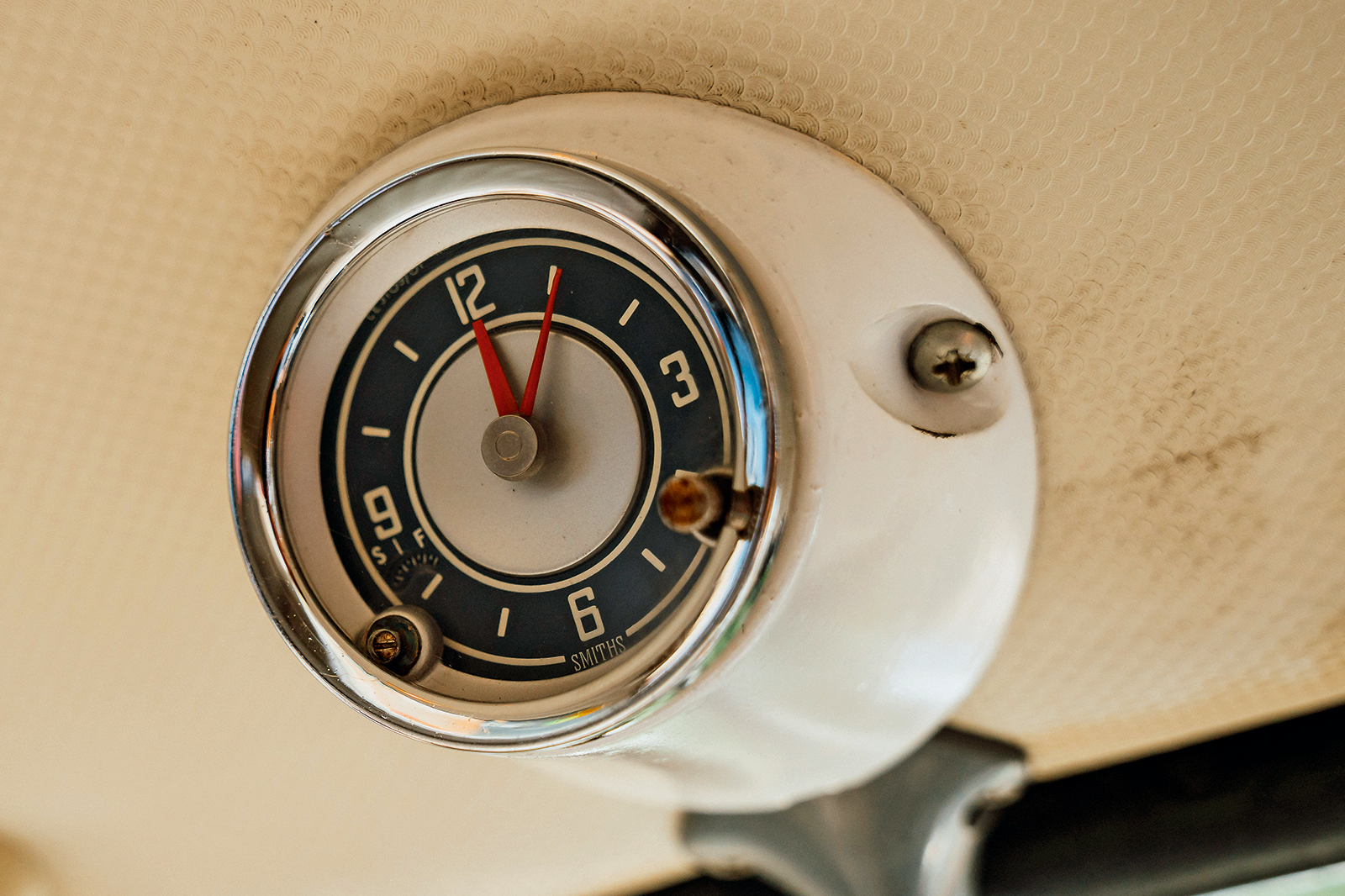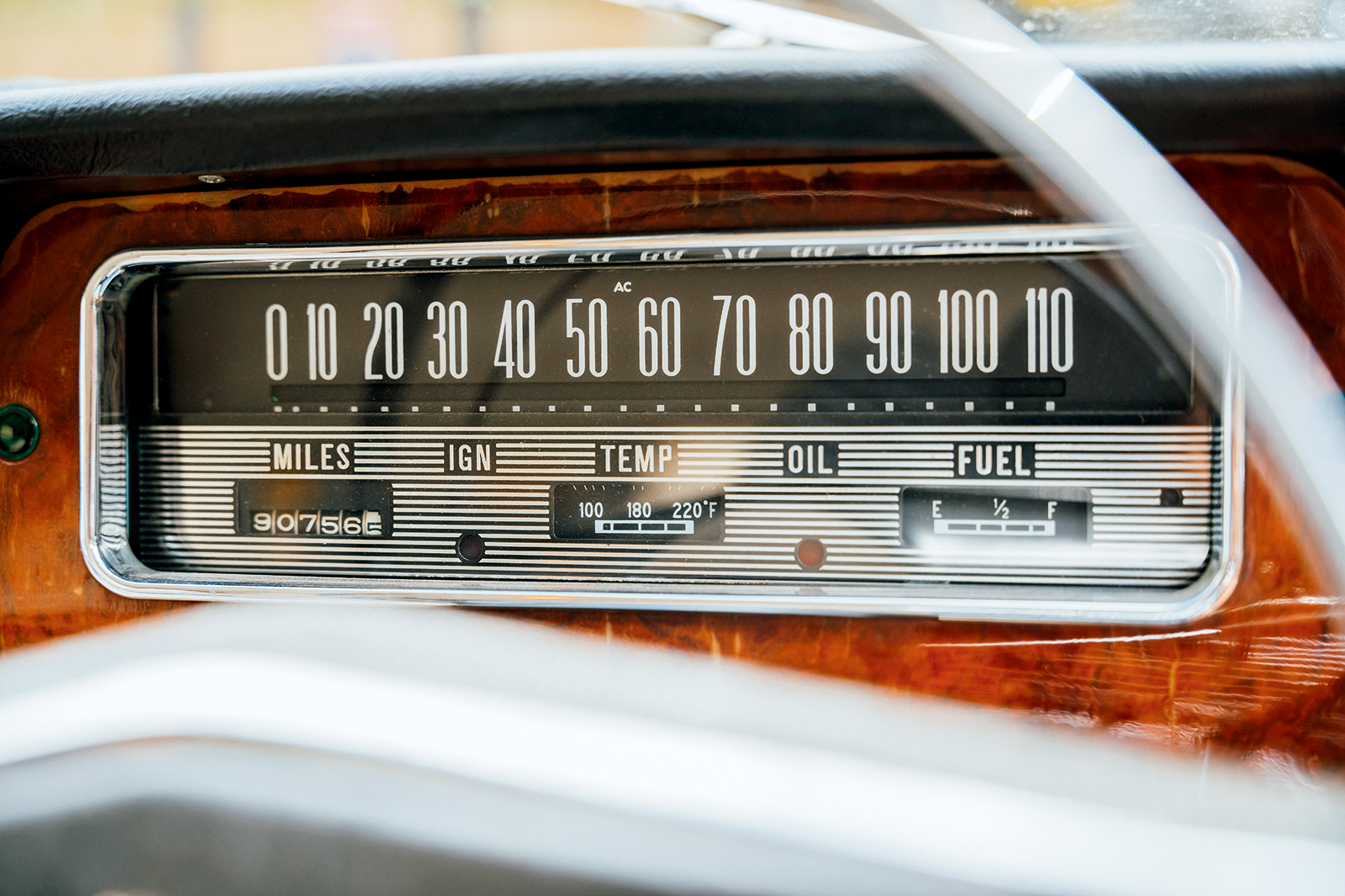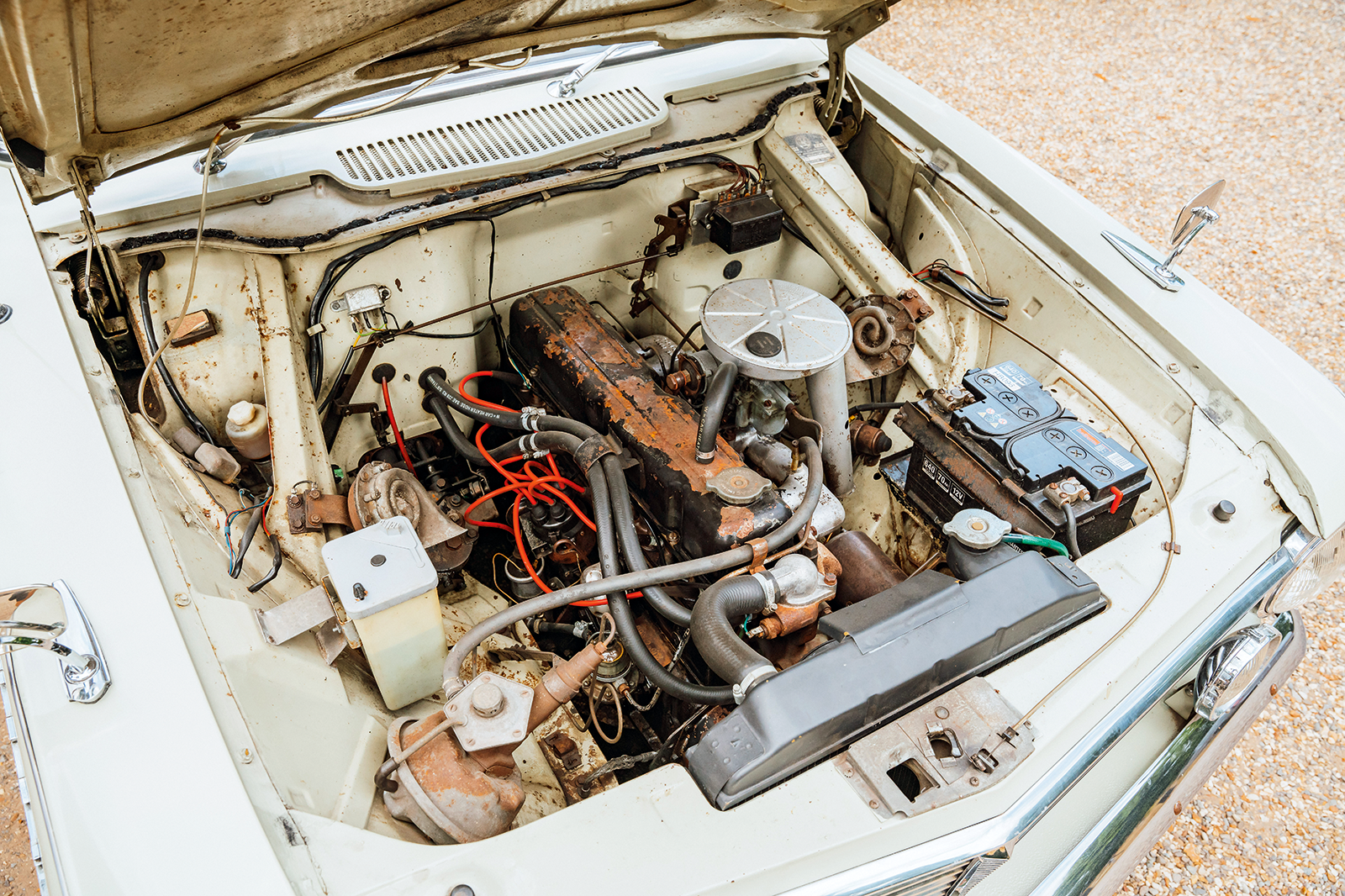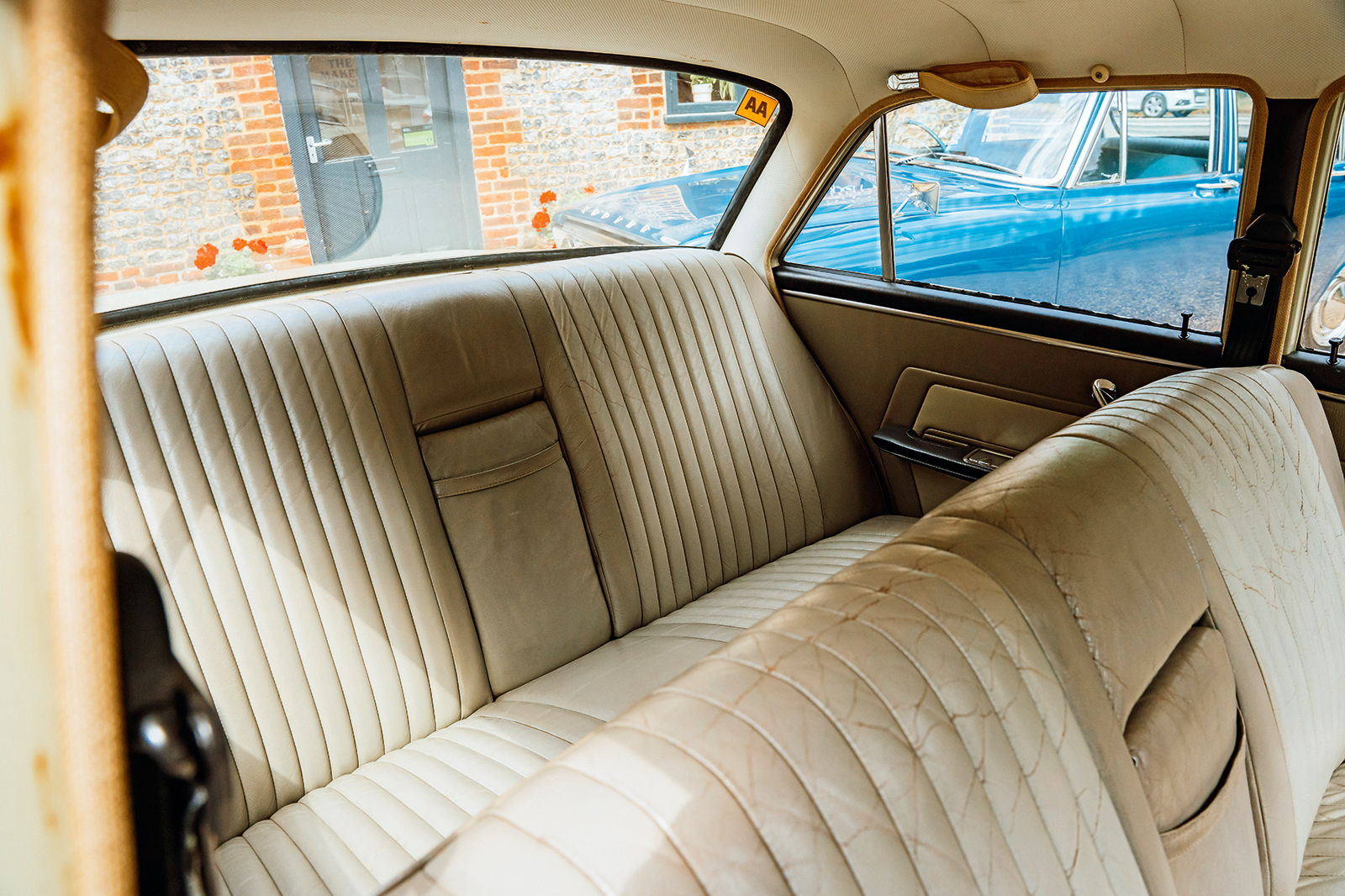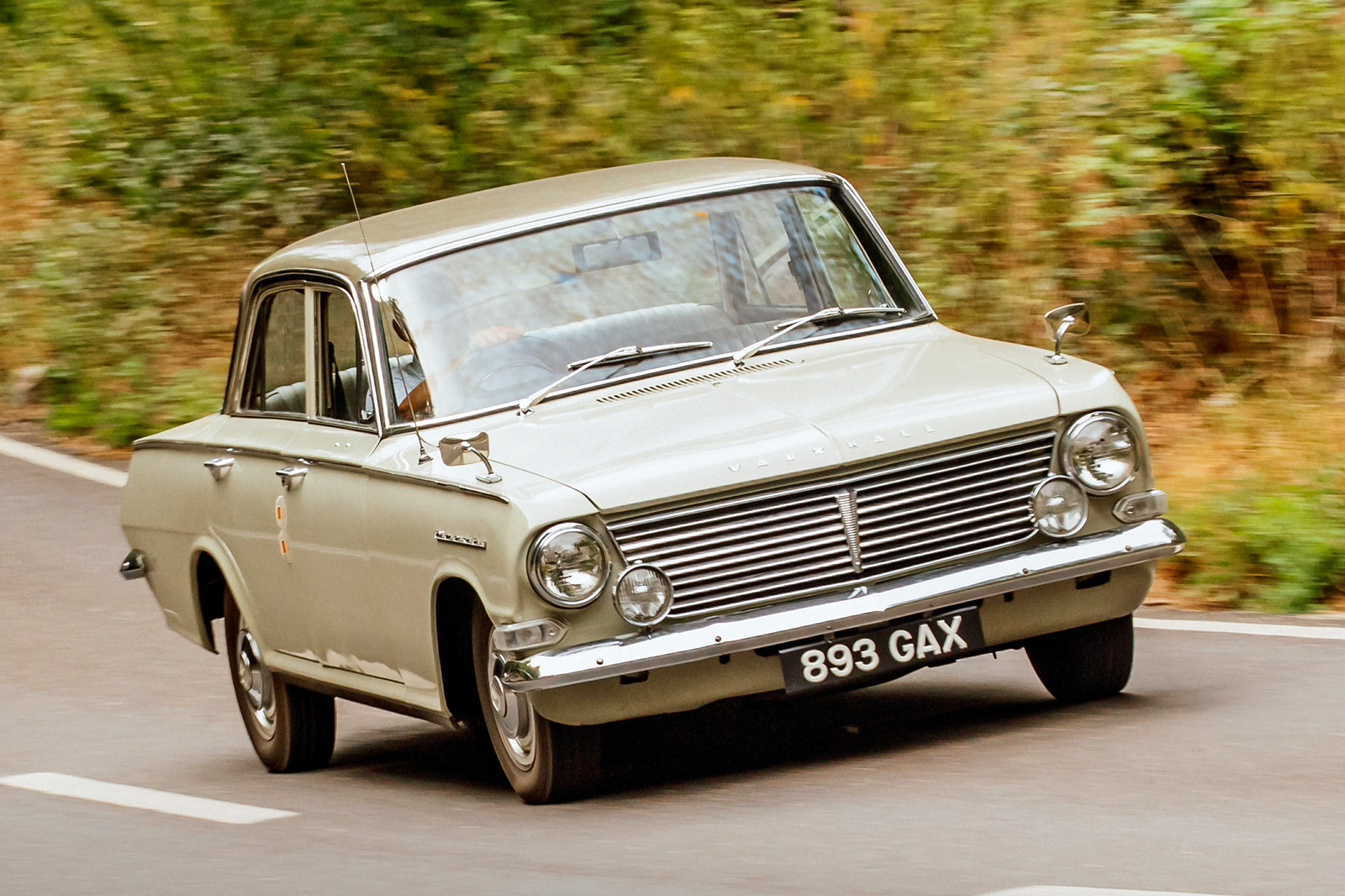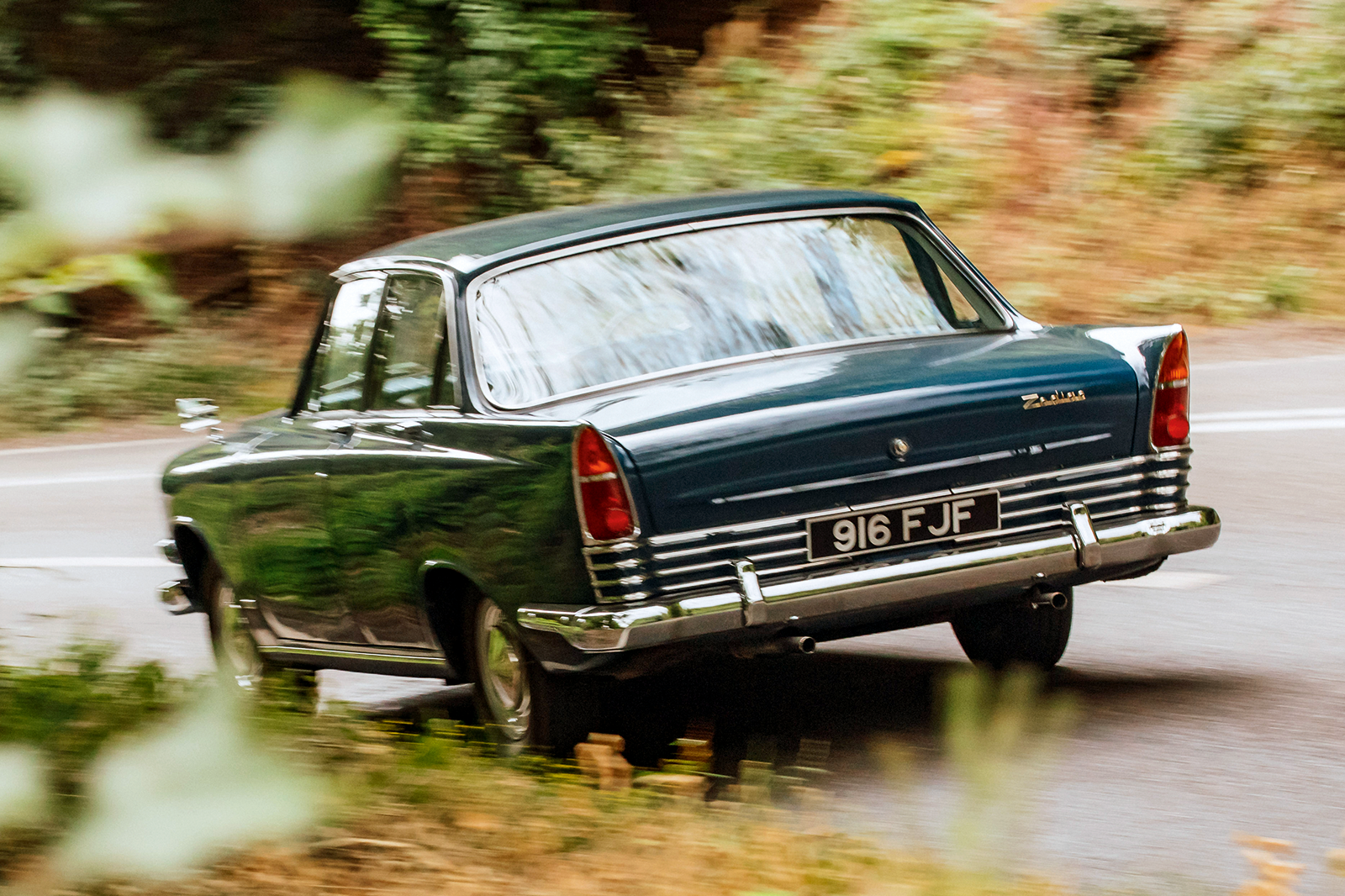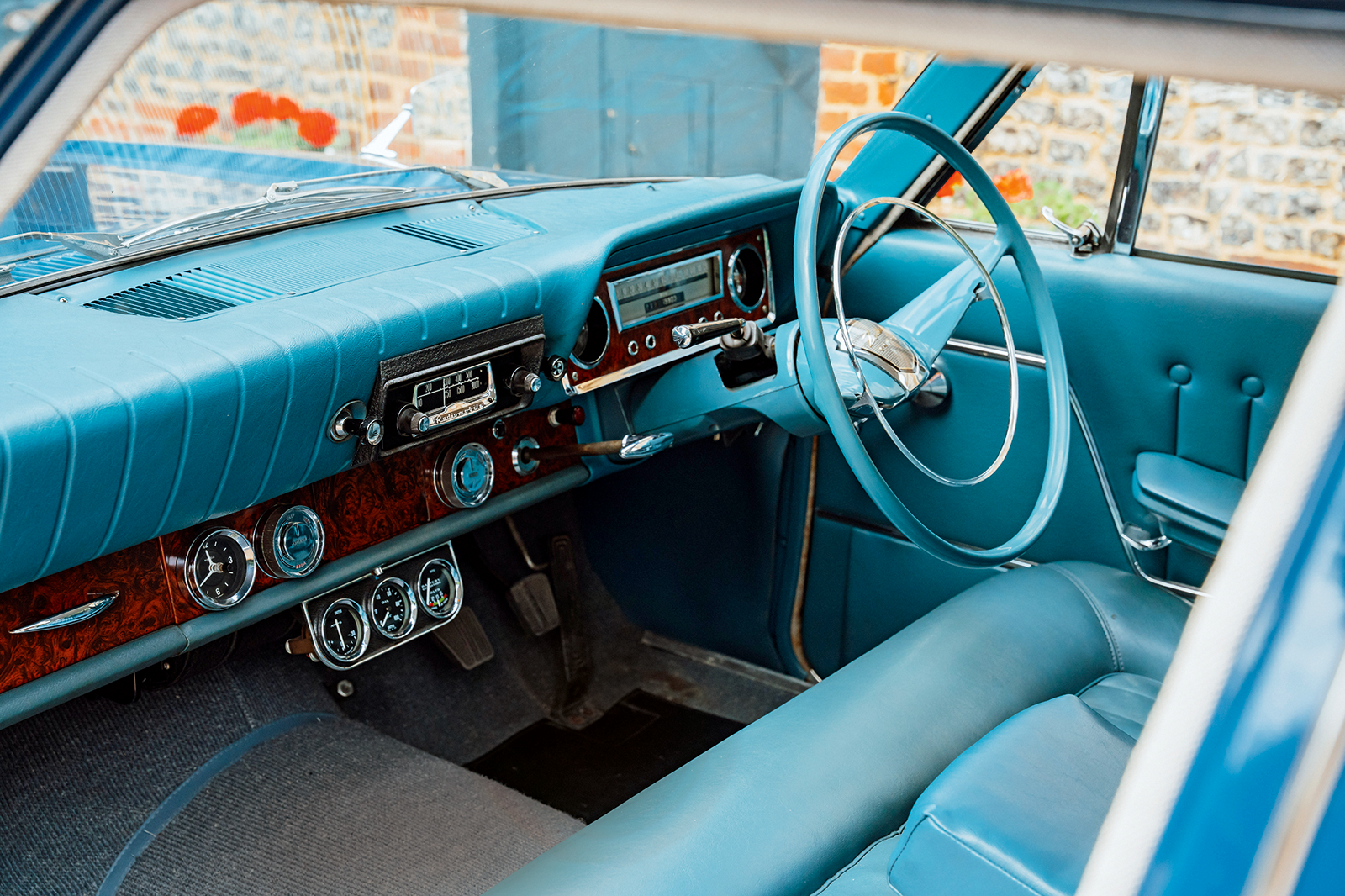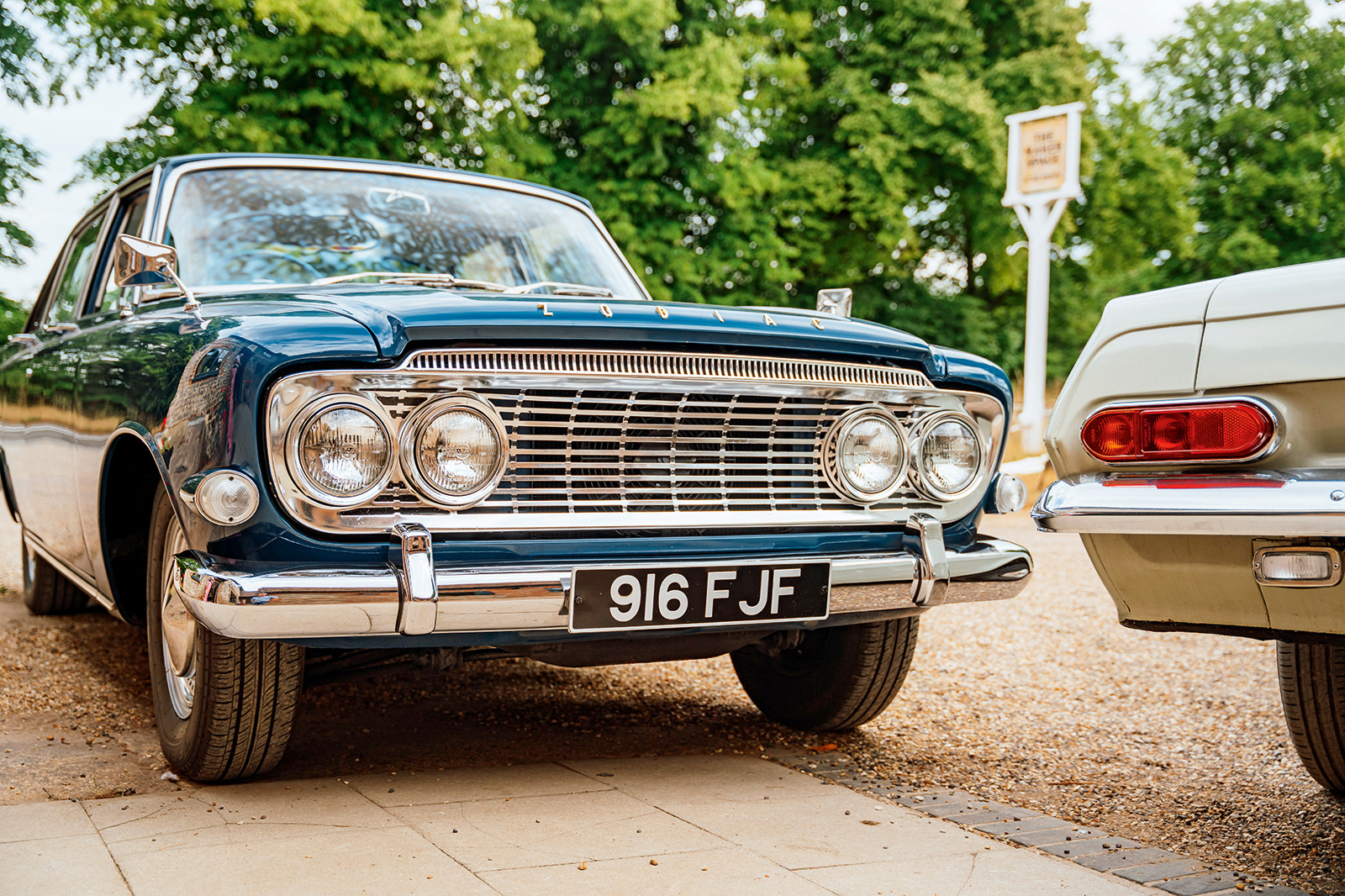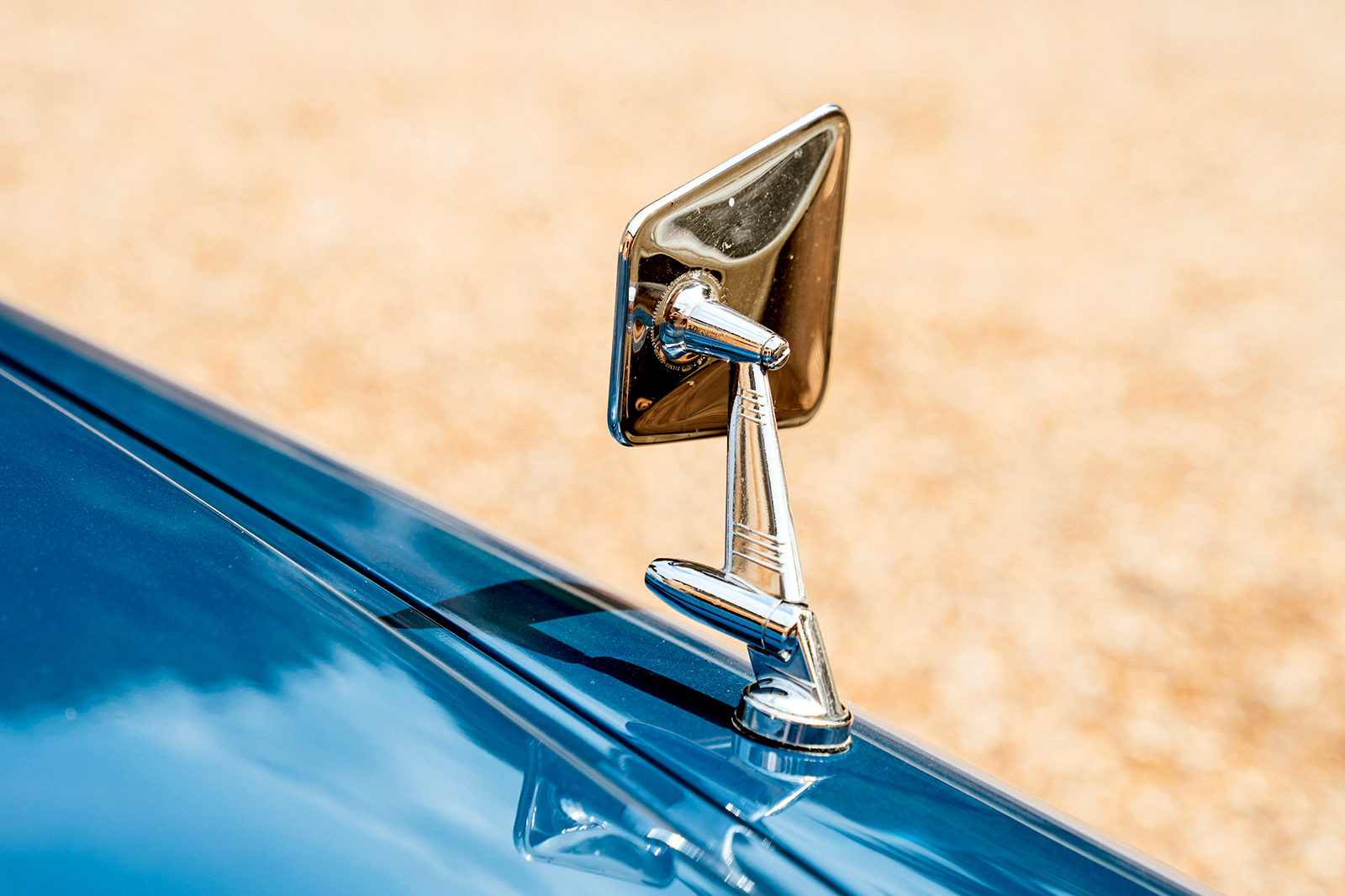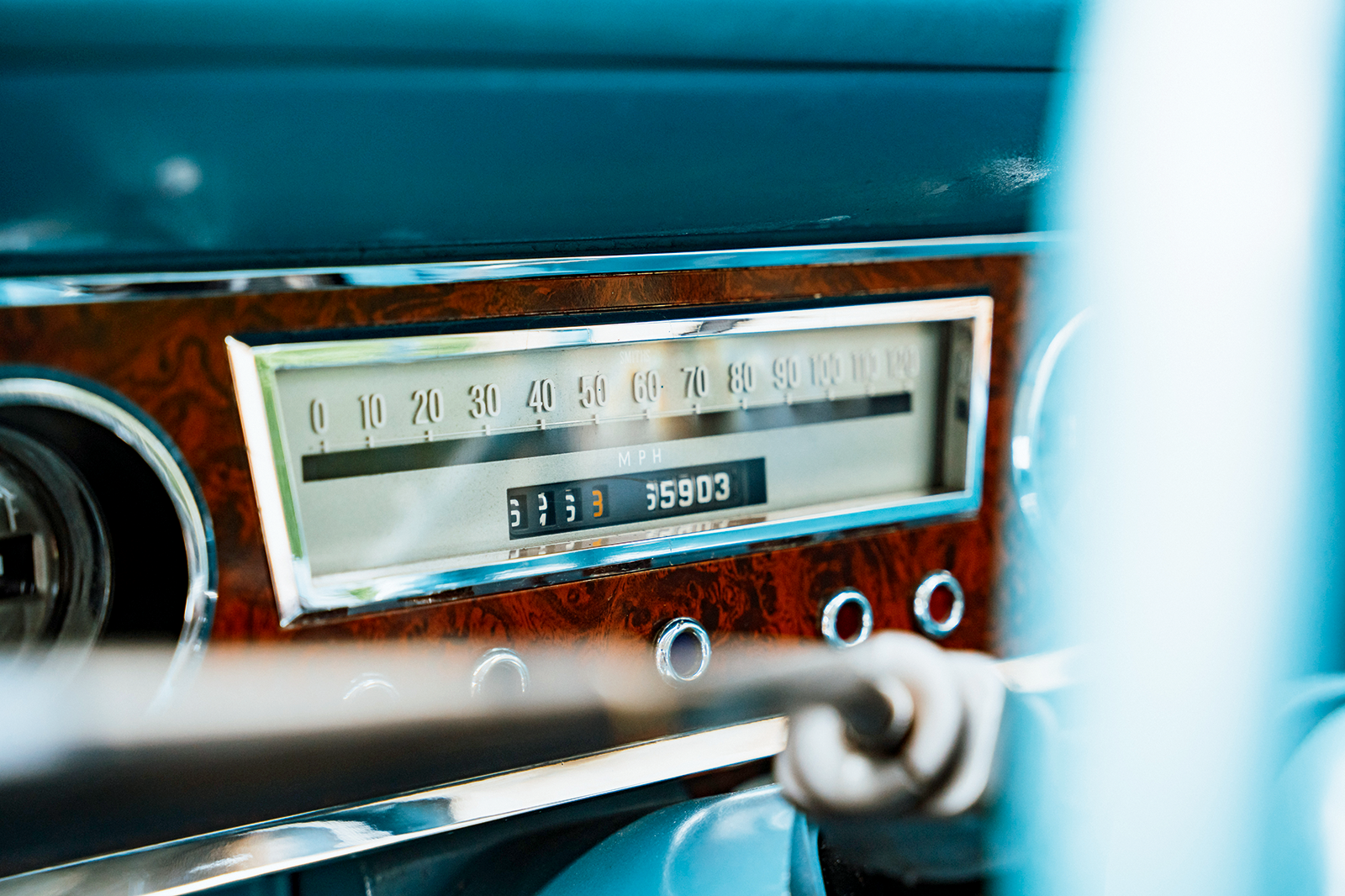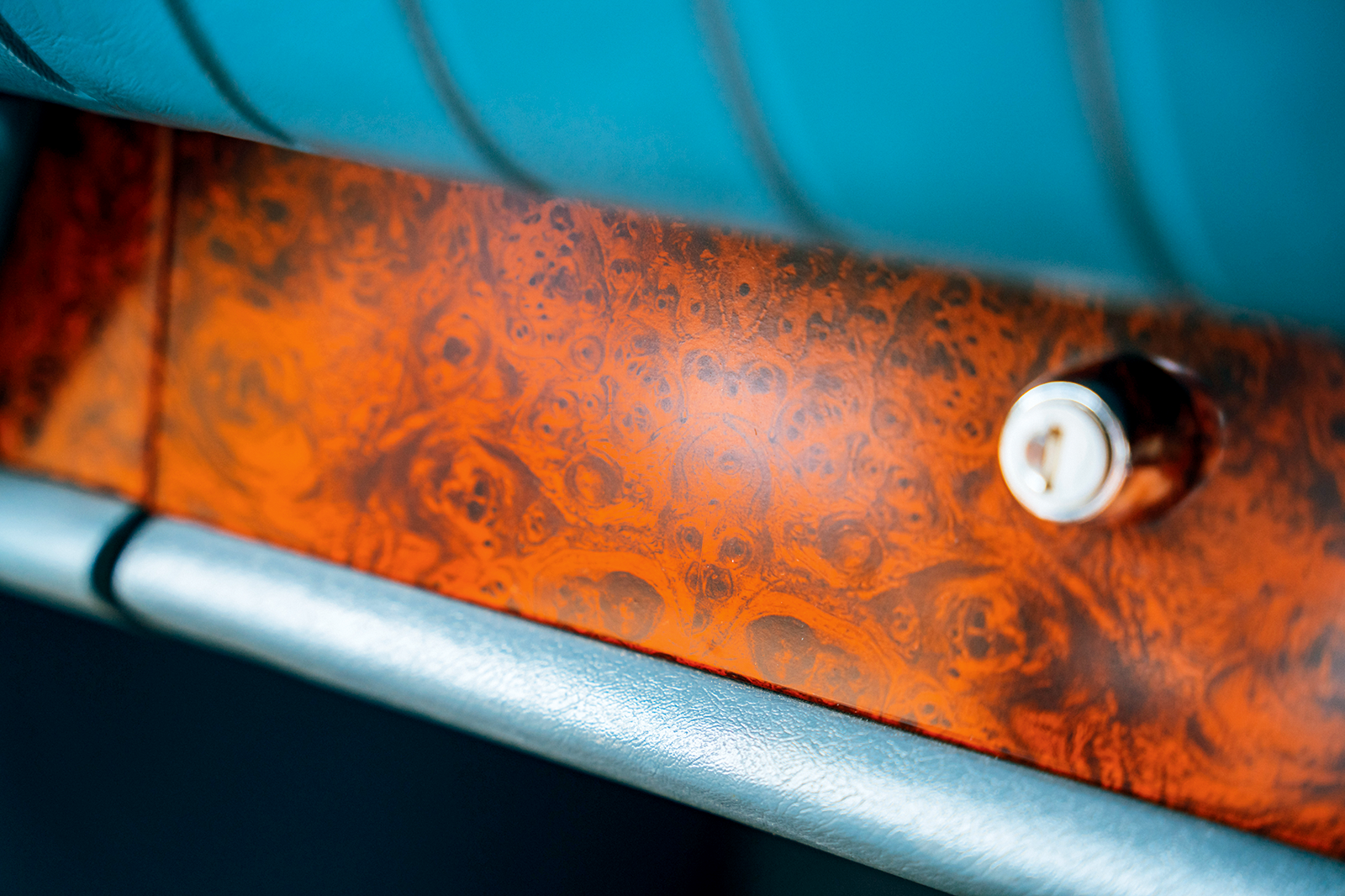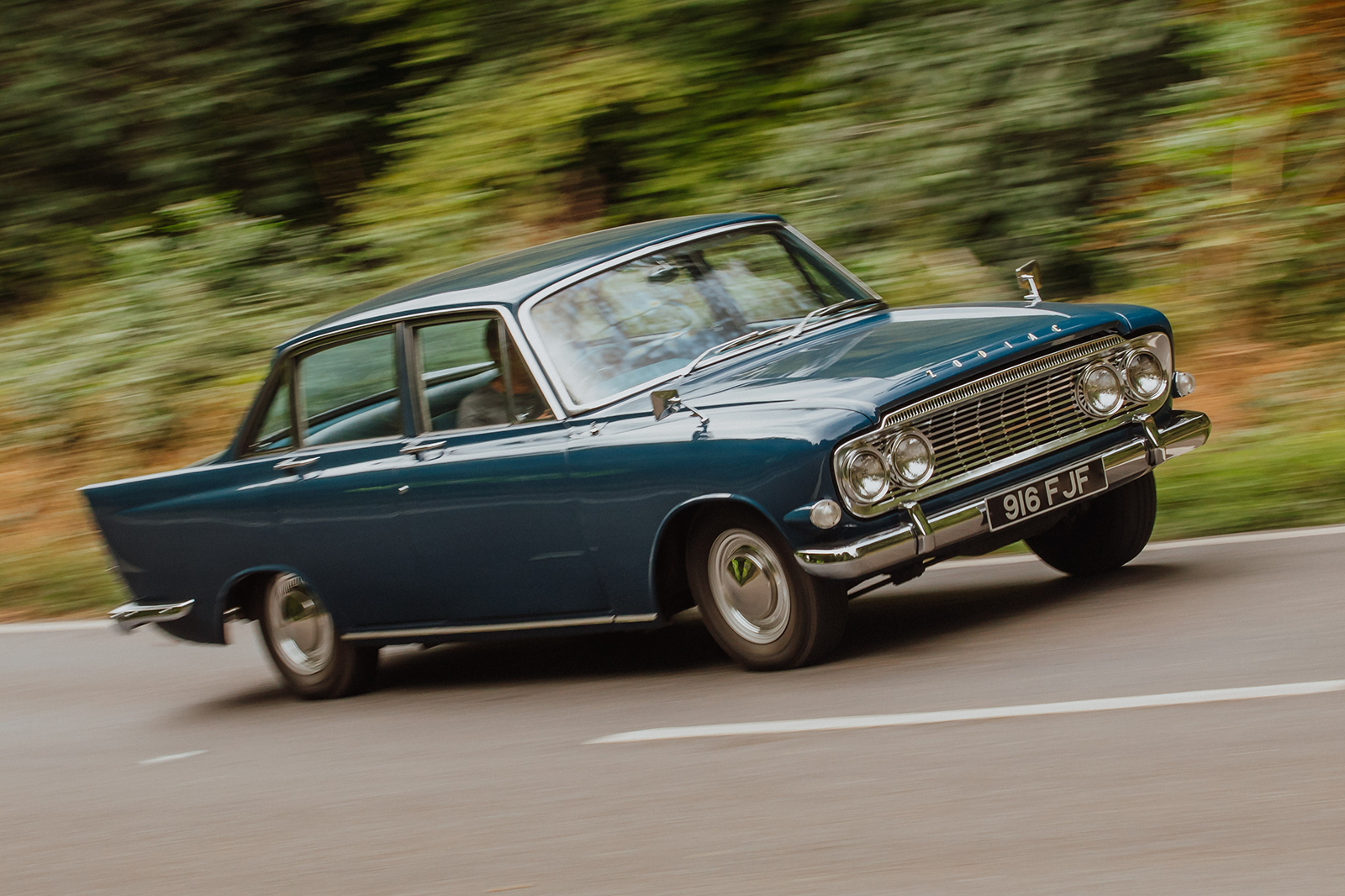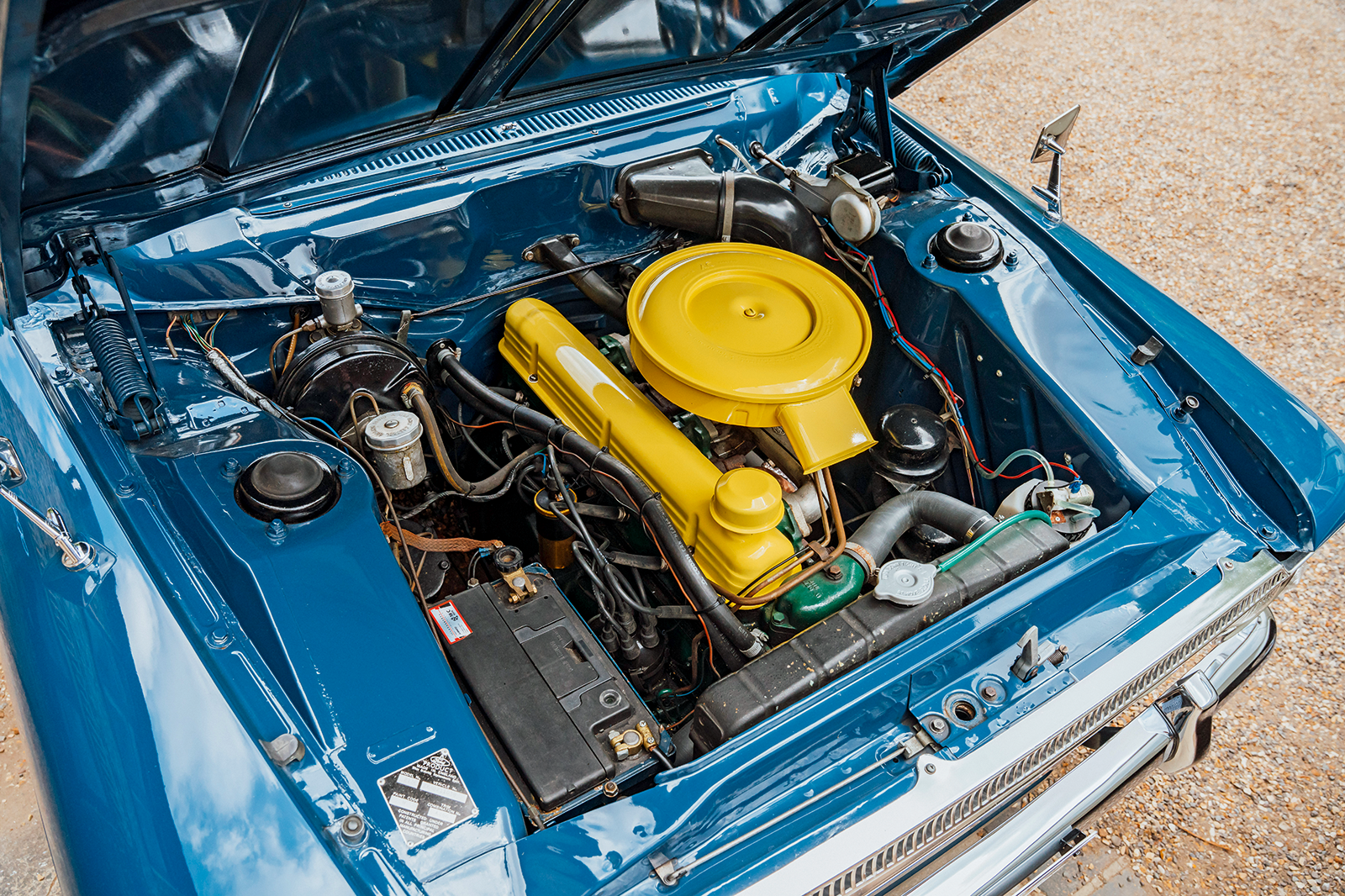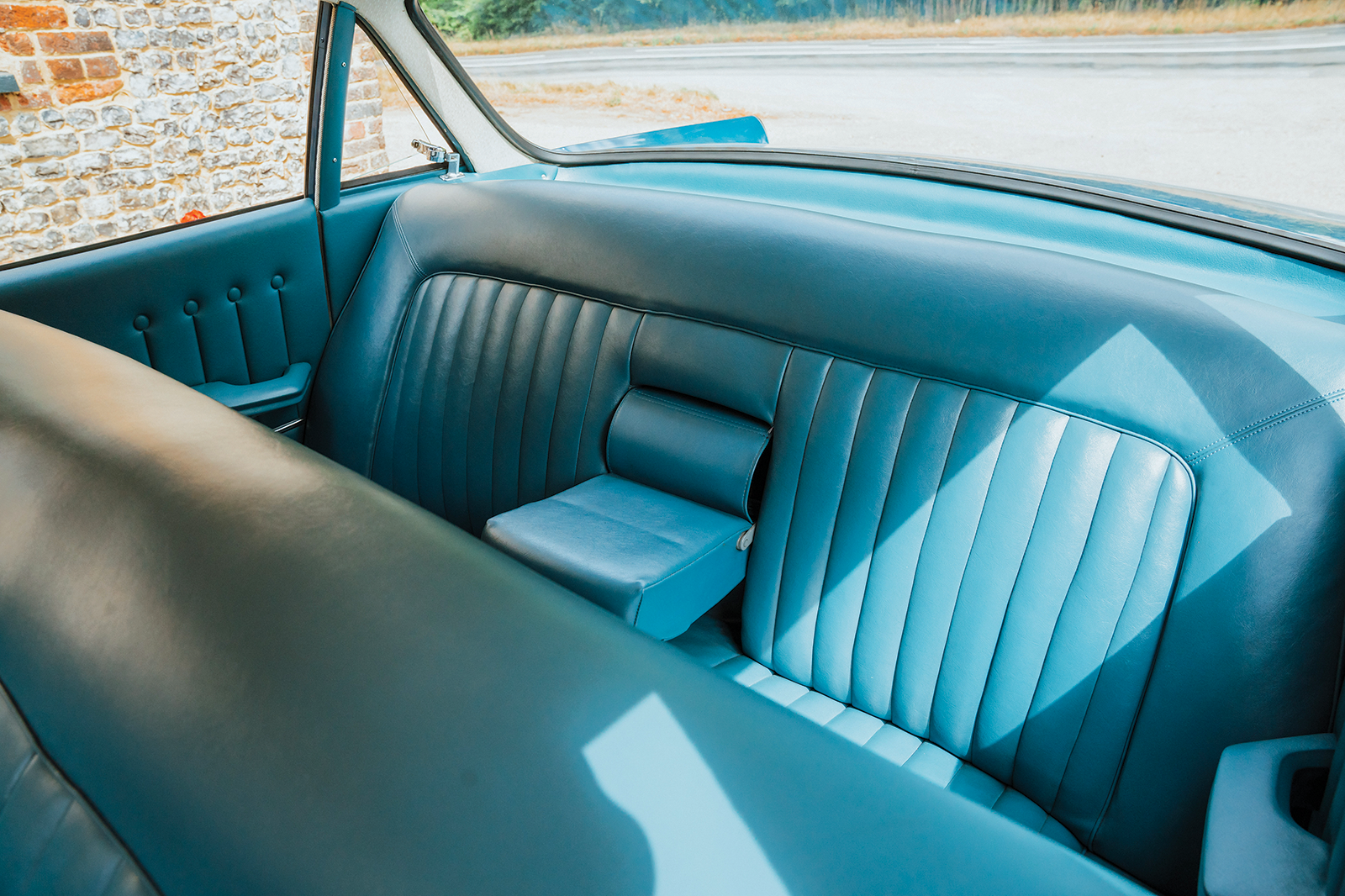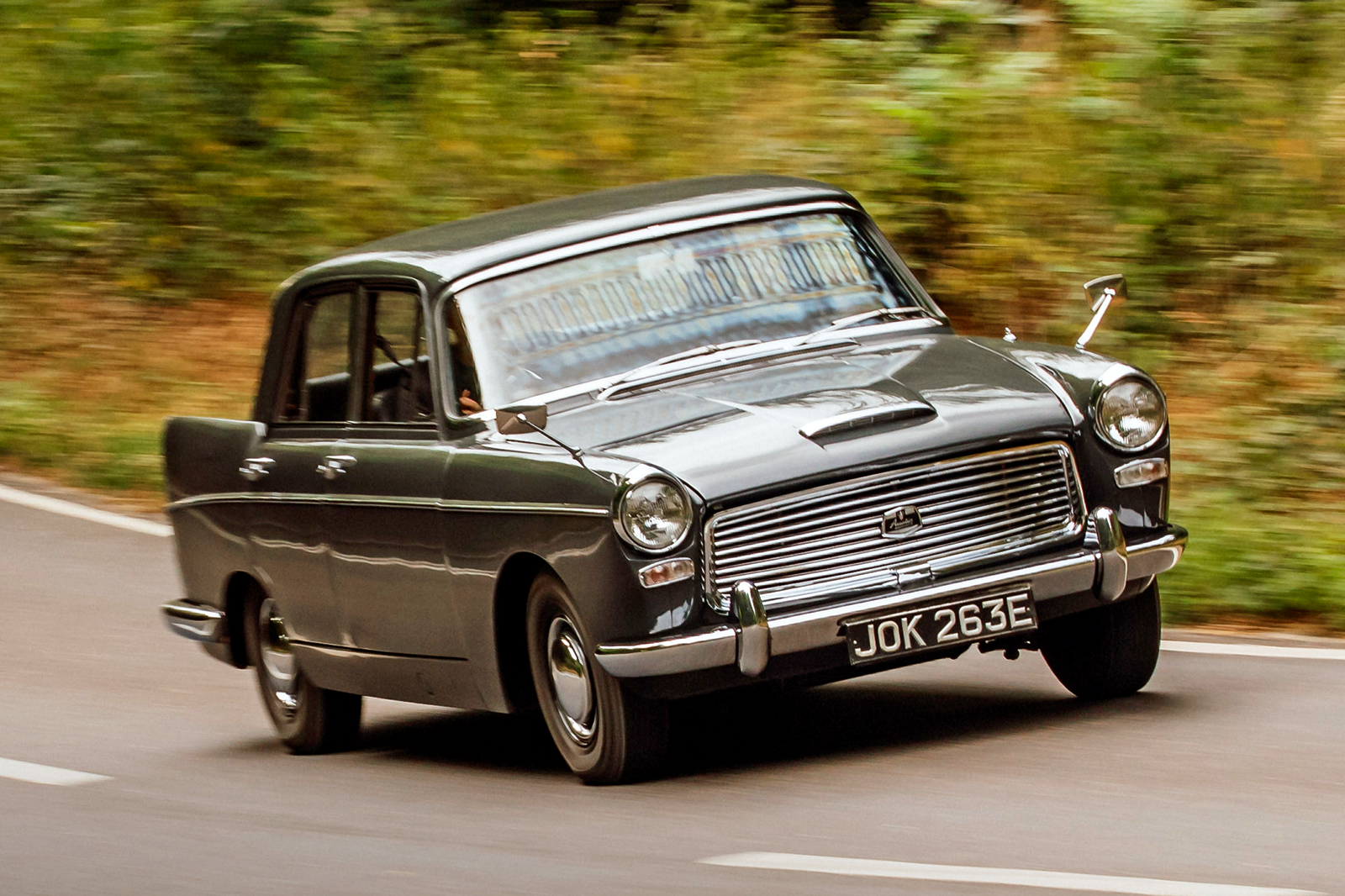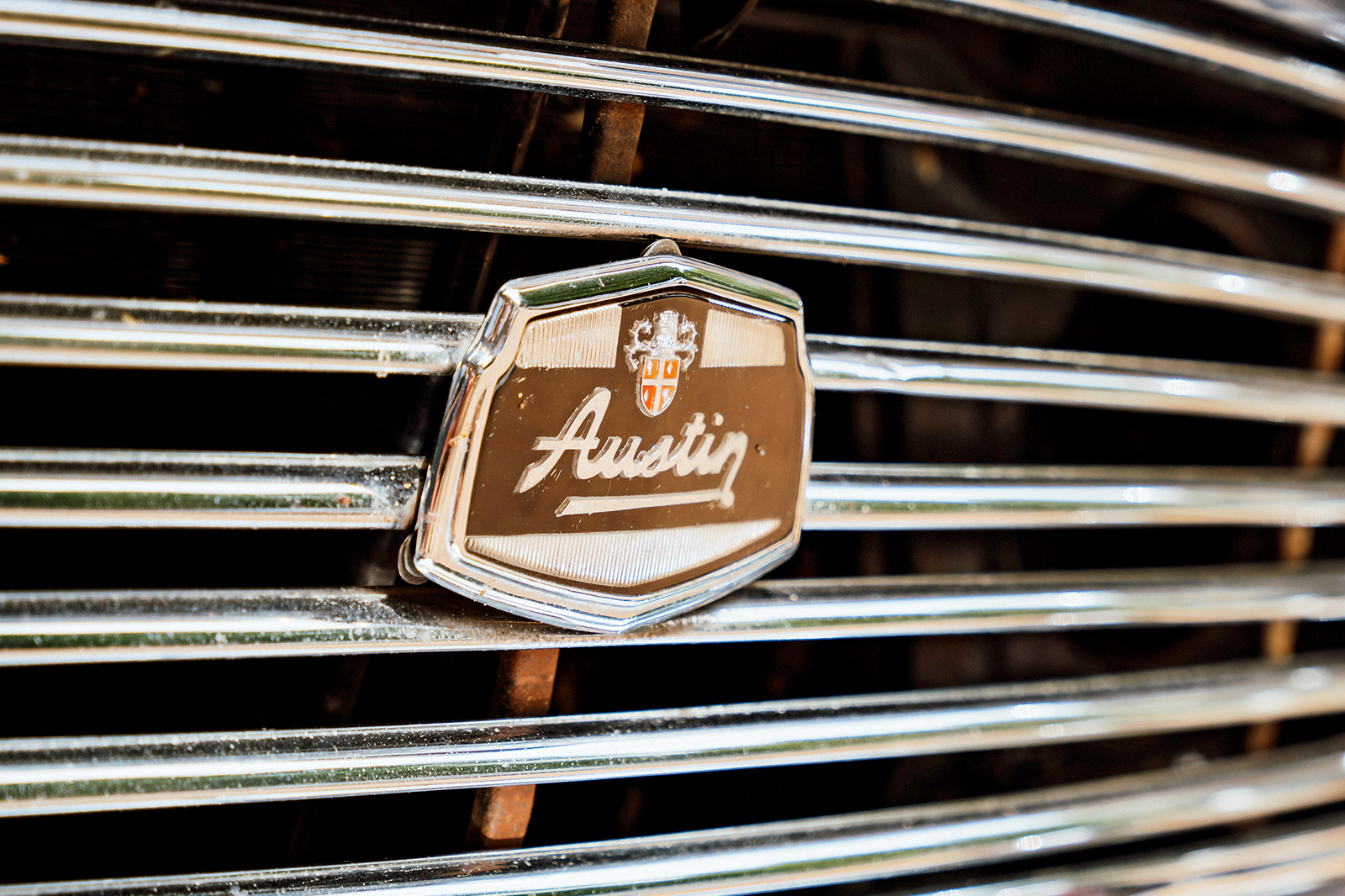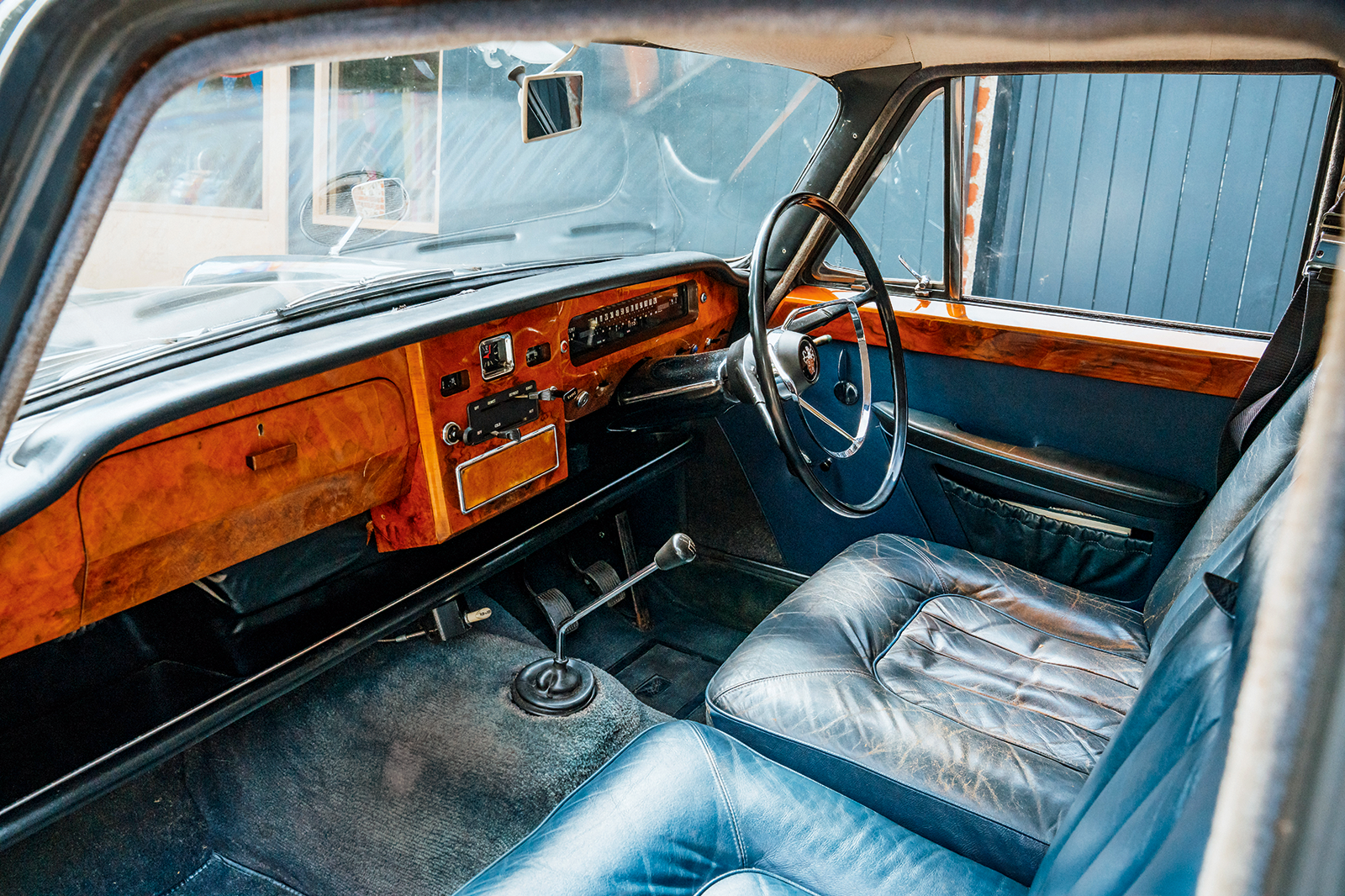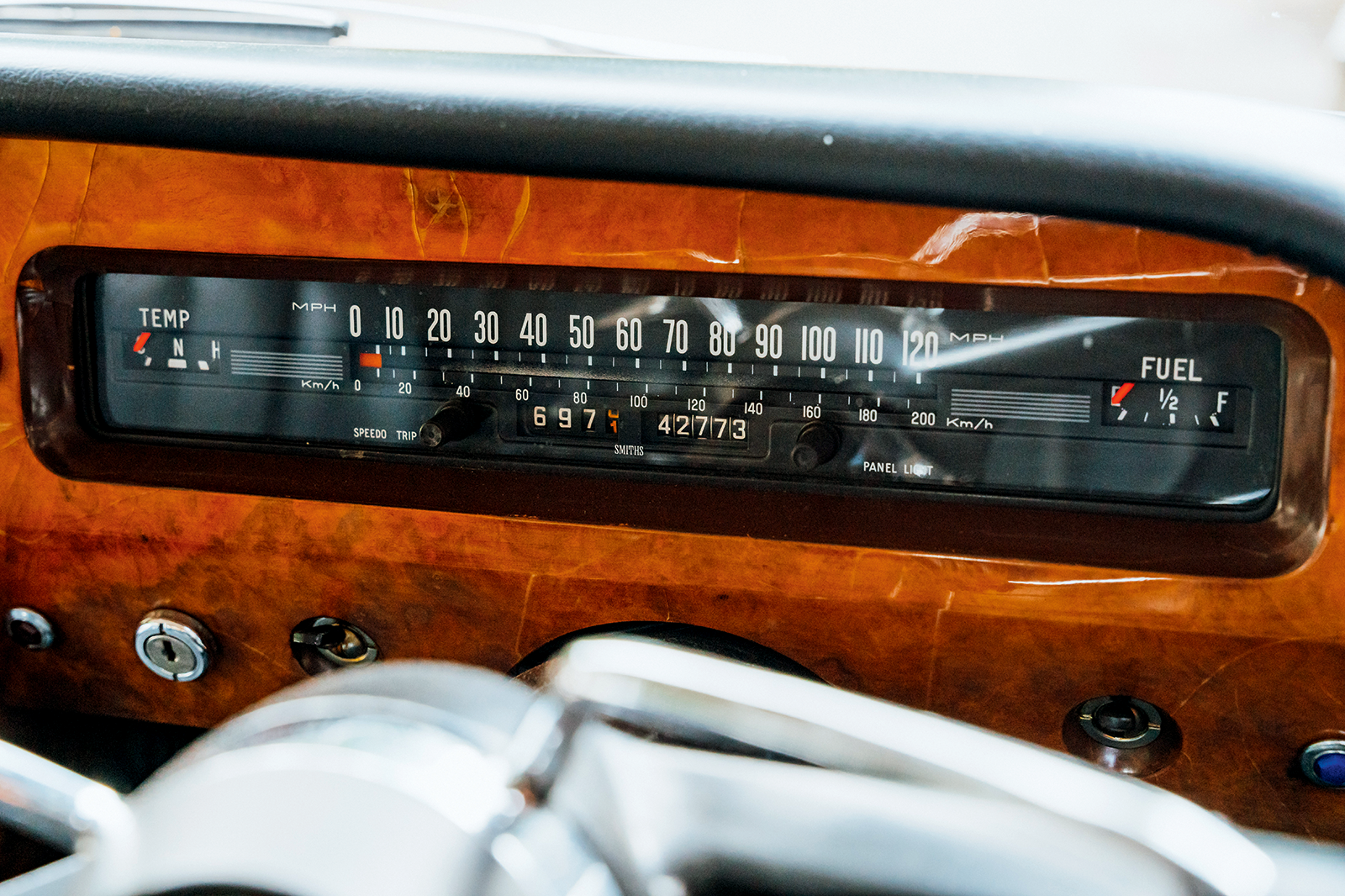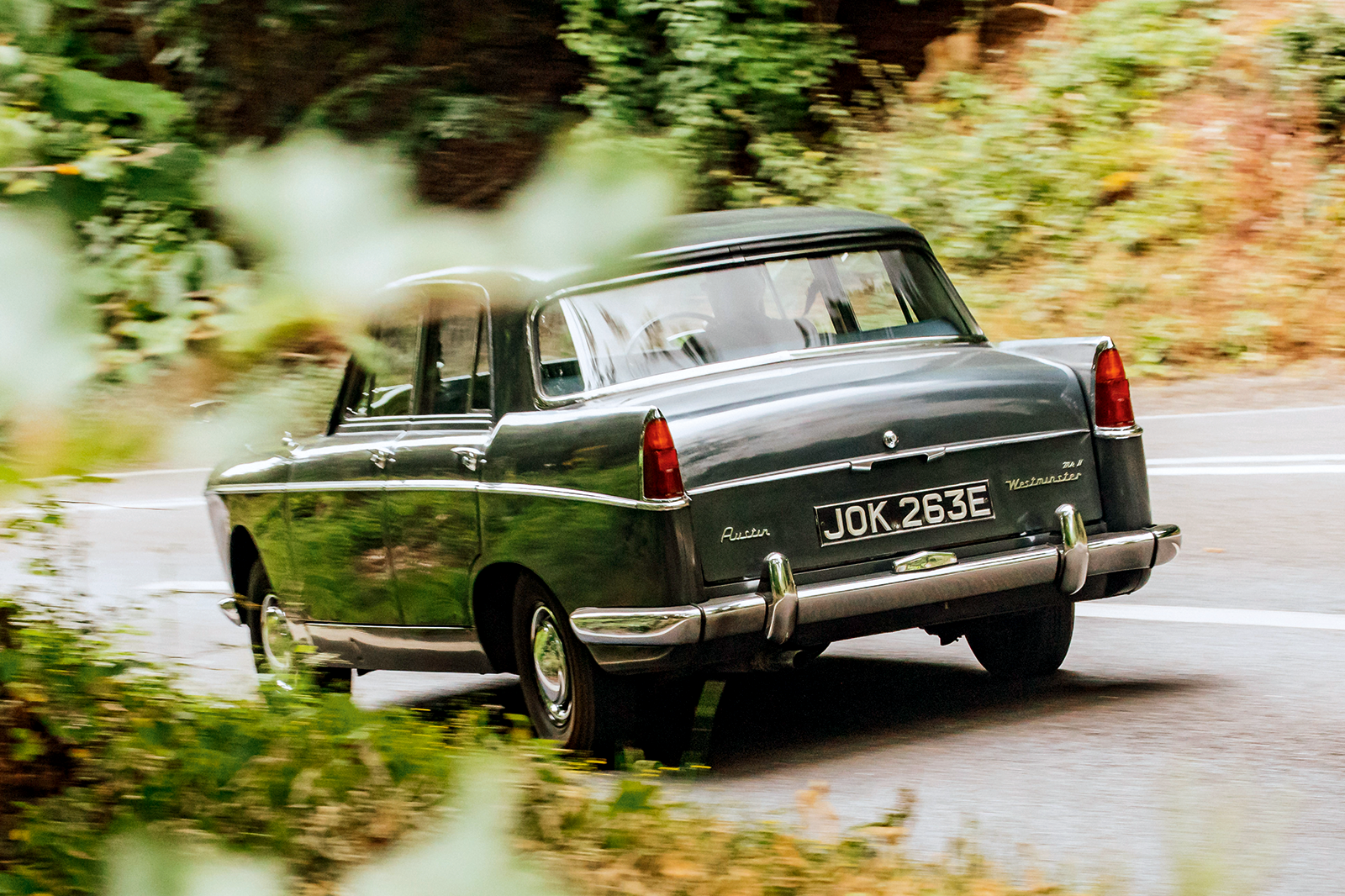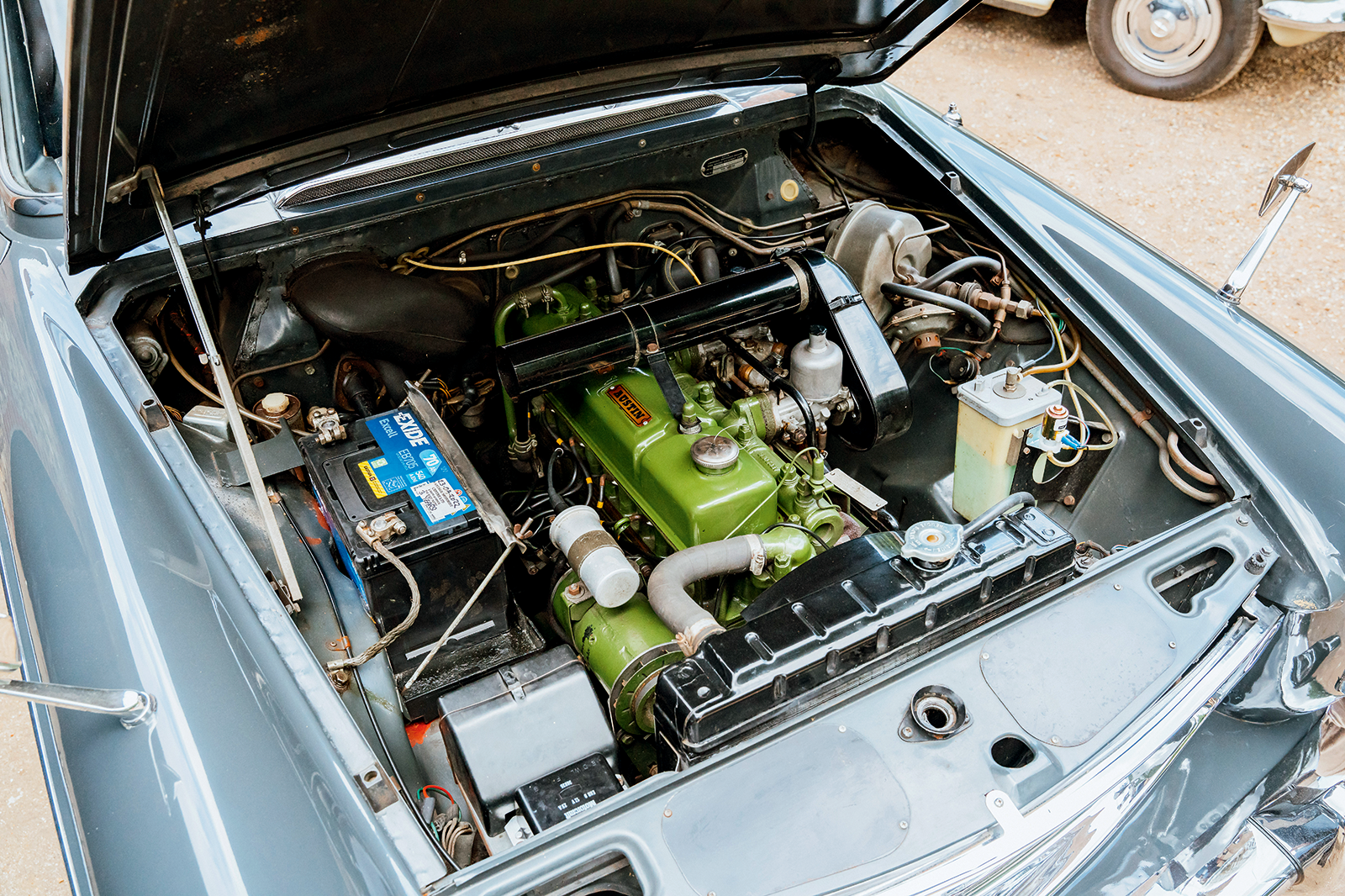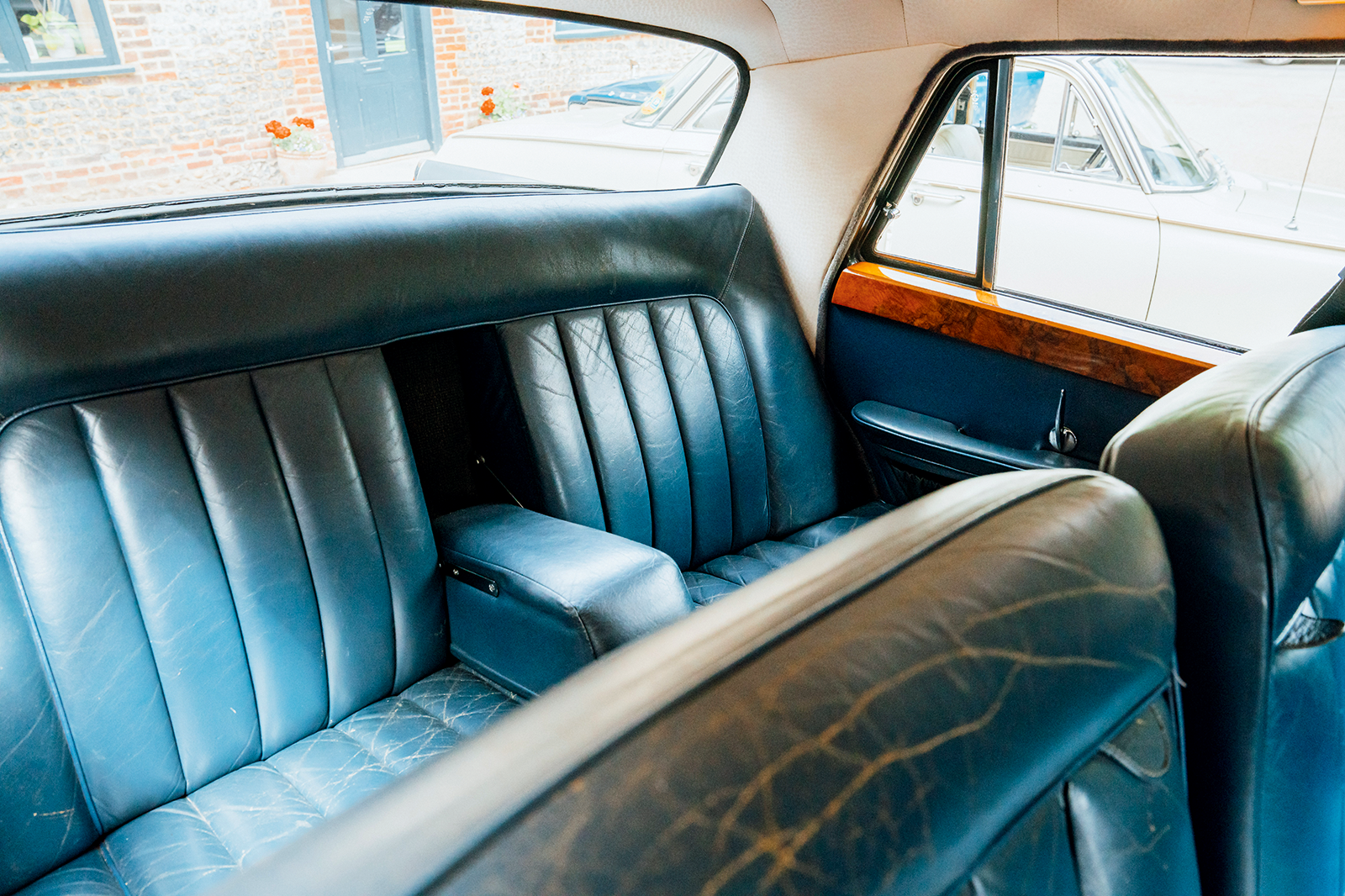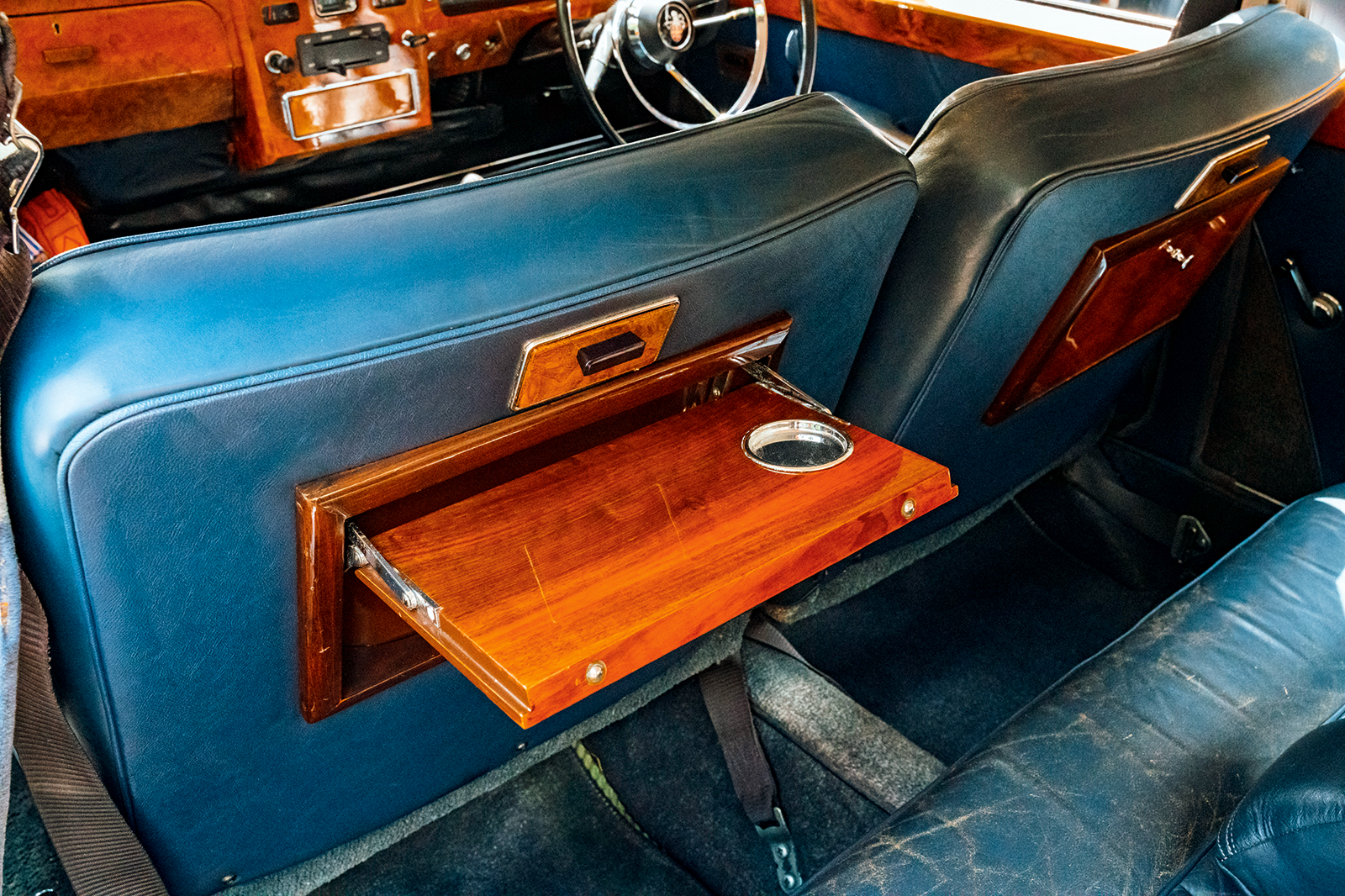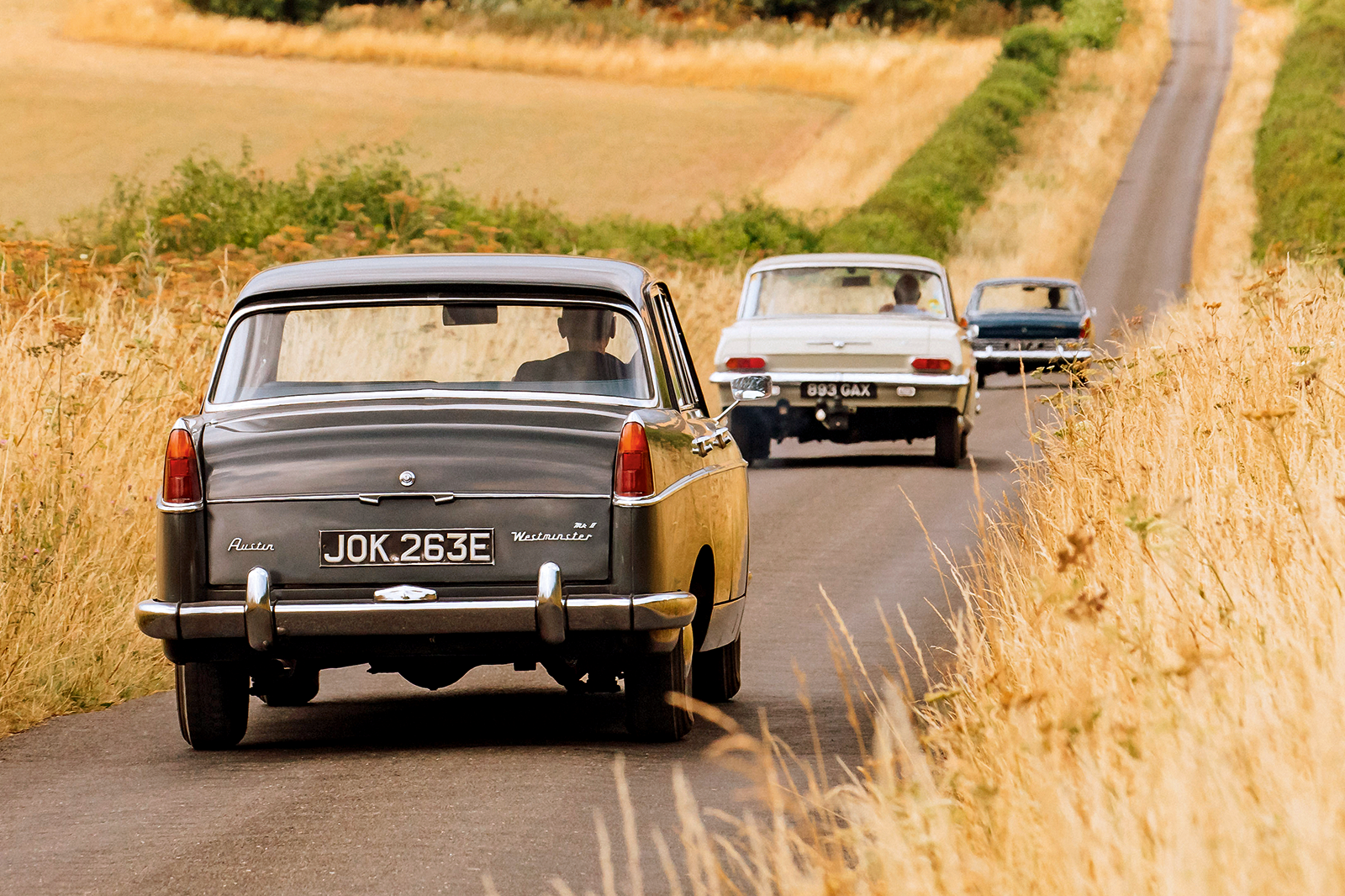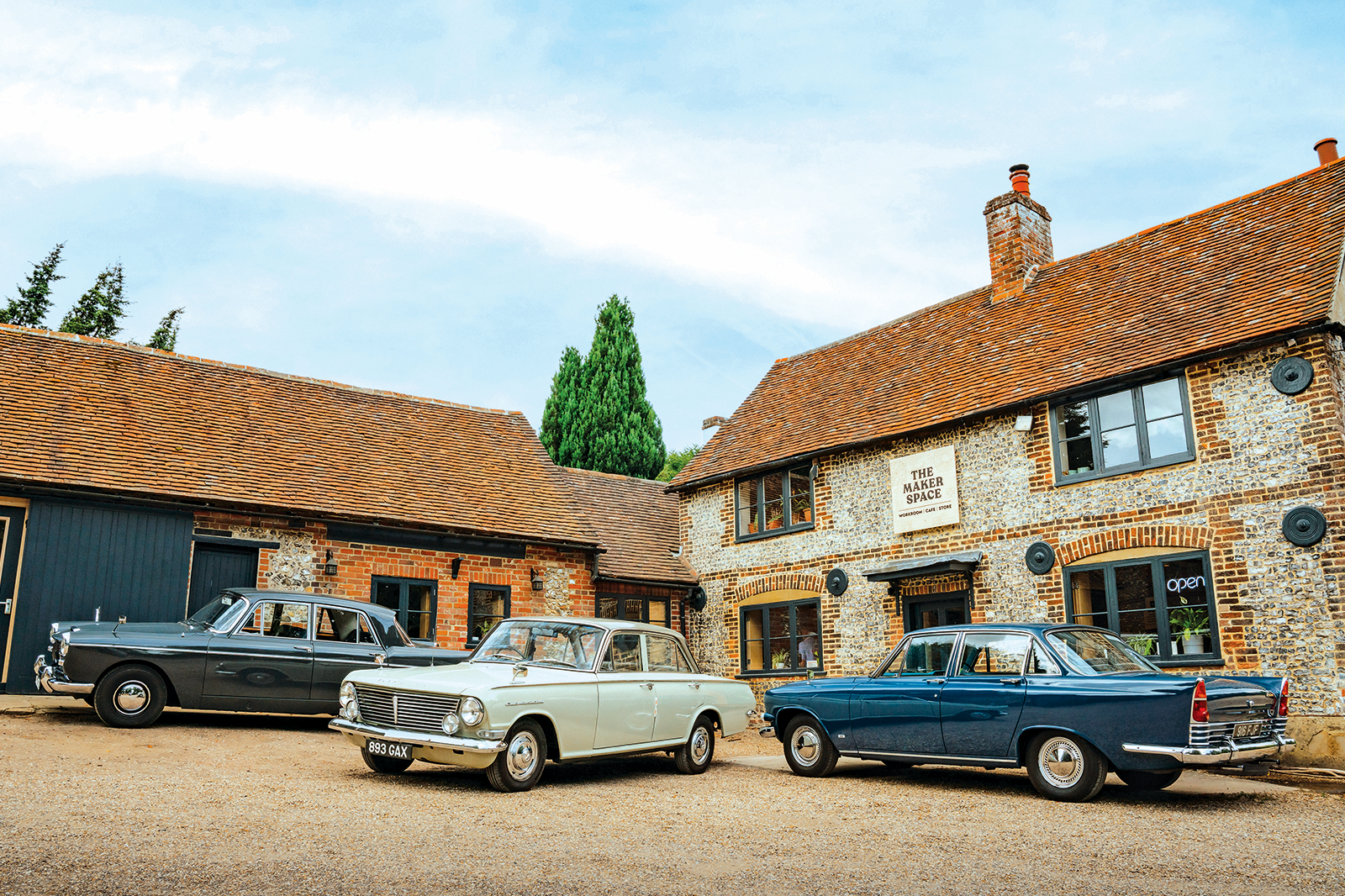Not only was it ‘resplendent in an array of dignified colours’, but ‘a car of distinction, for people of distinction’ and perfect for ‘top business executives in a hurry’.
Somewhat more prosaically, Autocar called it: ‘Sedate in appearance, and roomy… eminently suitable as executive transport’.
Another facelift came in 1964 as the MkII, with production ending in early 1968.
Modest badging on this classic Austin’s grille
By then, an Austin that initially rivalled the Zodiac MkII and Cresta PA was competing against the PC-series Vauxhalls and MkIV Fords.
Yet even the last Westminsters didn’t seem particularly archaic, thanks in part to their finely balanced proportions.
As a Wolseley 6/99 owner I have to admit to a certain bias, but those restrained Italian-American lines have dated very well.
The Austin A110 Westminster has a comfortable driving position
Any ‘Big Farina’ has an air of formality, making it the perfect transport for the town clerk or well-to-do solicitor.
Mark Shepley purchased his 1967 Austin A110 Westminster in 2011, and it is a prime example of the Super De Luxe, the flagship MkII with leather upholstery, rear picnic tables and a walnut-veneered dashboard for additional distinction.
It is the sort of vehicle in which the driver feels naked without a hat as they settle behind the vast steering wheel.
The classic Austin’s strip speedometer
As befitting a car for traditionally minded owners, the Westminster is also the sole member of our trio with a starting-handle bracket.
A further reason for choosing the Austin over the Ford or the Vauxhall is the 3-litre C-series engine.
The testers at Autocar found that the Westminster could ‘pull away from other traffic in a manner that is both impressive and refined’.
The Austin’s Italian-American lines and tailfins have aged well
Today Mark can only agree, and finds more to appreciate: “It’s wonderfully smooth, with a lovely upright driving position – no backache driving this car!
“It is also easy to place on the road because it’s so much narrower than most moderns. Plus, the quarterlights make for good, hassle-free ventilation.”
Apart from heavy fuel consumption, there are only a few downsides to Westminster ownership.
The Austin’s 2.9-litre C-series engine is smooth and tractable
“The gearbox is a bit agricultural compared with a modern equivalent,” Mark admits, “and although the overdrive engages smoothly, it can be reluctant to kickdown out of it – hills should be planned for.”
At least there’s less to worry about on the way back down. “For a 1960s car, the brakes are incredibly good,” he adds, encouragingly.
Another challenge, one that is familiar to many Big Farina owners, is the dynamo’s weak supply of electricity, which rather exacerbates the efficacy of the poor wipers: “Night driving in the rain can be somewhat challenging, though it’s rare I’d want to do such a thing.”
Cushy rear seats for rear passengers in the A110 Westminster
Each of our test cars is now a rare sight due to the effects of age and corrosion. Many have also fallen prey to the strange world of banger racing.
Various large saloons of the ’60s being smashed to pieces in a stadium apparently represented a form of automotive Viking funeral.
The Cresta, Westminster and Zodiac are reminders of a more hierarchical age, a time when major British motor manufacturers still felt it essential to produce a car for the managerial class.
The Super De Luxe Austin A110 Westminster gained rear picnic tables
Nor did the 1963 introduction of the Rover P6 and Triumph 2000 bring about an immediate end to these big Austin, Ford and Vauxhall models.
The new school appealed to young executives with Continental aspirations, while Crestas, Westminsters and Zodiacs were for more mature drivers, those who equally valued convention and mild ostentation.
If I opt for the Vauxhall, it is partially due to its elegant appearance, but mainly because it embodies a time in England when mainstream entertainers adopted quasi-American accents and many drivers still perceived motorway travel to be vaguely glamorous.
The Austin A110 Westminster (closest), Vauxhall Cresta PB (middle) and Ford Zodiac MkIII are reminders of a more hierarchical age
For that dash up the M1 to the Blue Boar café, a duotone PB would have been perfect.
In those heady days, a new Cresta epitomised an exciting world of expense-account fine dining and trying to sound as mid-Atlantic as Cary Grant.
Plus, there’s always revelling in owning a car that was ‘designed for good driving’.
Images: Luc Lacey
Thanks to: The Maker Space, Nuffield; The Cambridge-Oxford Owners’ Club; MkIII Zephyr & Zodiac Owners’ Club; Vauxhall Cresta Club
Factfiles
Austin A110 Westminster Super De Luxe
- Sold/number built 1961-’68/26,105
- Construction steel monocoque
- Engine all-iron, ohv 2912cc straight-six, twin SU carburettors
- Max power 120bhp @ 4750rpm
- Max torque 163lb ft @ 2750rpm
- Transmission four-speed manual with overdrive, RWD
- Suspension: front independent, by wishbones, coil springs, anti-roll bar rear live axle, semi-elliptic leaf springs; telescopic dampers f/r
- Steering cam and peg
- Brakes discs front, drums rear
- Length 15ft 7¾in (4769mm)
- Width 5ft 8½in (1740mm)
- Height 5ft ½in (1537mm)
- Wheelbase 9ft 2in (2794mm)
- Weight 3190lb (1445kg)
- 0-60mph 16.2 secs
- Top speed 102mph
- Mpg 18
- Price new £1114 2s 4d
- Price now £7-13,000*
Ford Zodiac MkIII
- Sold/number built 1962-’66/77,709
- Construction steel monocoque
- Engine all-iron, ohv 2553cc straight-six, single Zenith carburettor
- Max power 109bhp @ 4800rpm
- Max torque 137lb ft @ 2400rpm
- Transmission four-speed manual, RWD
- Suspension: front independent, by MacPherson struts, anti-roll bar rear live axle, semi-elliptic leaf springs, lever-arm dampers
- Steering recirculating ball
- Brakes discs front, drums rear
- Length 15ft 1in (4497mm)
- Width 5ft 9in (4445mm)
- Height 4ft 9½in (1460mm)
- Wheelbase 8ft 11in (2718mm)
- Weight 3150lb (1429kg)
- 0-60mph 13.5 secs
- Top speed 103mph
- Mpg 18
- Price new £1070 15s 3d
- Price now £8-16,000*
Vauxhall Cresta PB
- Sold/number built 1962-’65/87,047
- Construction steel monocoque
- Engine all-iron, ohv 2651cc straight-six, single Zenith carburettor
- Max power 95bhp @ 4600rpm
- Max torque 148lb ft @ 2400rpm
- Transmission three-speed manual with overdrive, RWD
- Suspension: front independent, by wishbones, coil springs, anti-roll bar rear live axle, semi-elliptic leaf springs; telescopic dampers f/r
- Steering recirculating ball
- Brakes discs front, drums rear
- Length 15ft 2in (4623mm)
- Width 6ft (2083mm)
- Height 4ft 10in (1473mm)
- Wheelbase 8ft 11in (2718mm)
- Weight 2716lb (1232kg)
- 0-60mph 13.8 secs
- Top speed 94mph
- Mpg 18
- Price new £918 17s 11d
- Price now £5-10,000*
*Prices correct at date of original publication
Enjoy more of the world’s best classic car content every month when you subscribe to C&SC – get our latest deals here
READ MORE
Luton chic: Vauxhall PA Cresta and F-series Victor
Buyer’s guide: Austin Cambridge & Westminster
Guilty pleasures: Ford Consul, Zephyr and Zodiac
Austin 3 Litre vs Wolseley Six: affordable luxury
Andrew Roberts
Andrew is a long-time contributor to Classic & Sports Car
